Malay cuisine beckons with a culinary symphony, weaving together the diverse cultural threads that shape Malaysia's flavor landscape. Amidst the tantalizing tapestry, ingredients like fragrant coconut rice, skewered and grilled meats, and spicy noodle soups create a harmonious blend of bold spices and culinary nuances. Each bite becomes a journey through the cultural influences that have converged over time, offering a unique and enchanting Malaysian gastronomic experience. In Malay cuisine, the art of flavors transcends names, inviting you to savor the essence of Malaysia's culinary identity in every dish.
Soto
-1708011200.jpg)
Soto, brimming with lively and bold flavors, artfully combines either chicken or beef with a diverse array of vegetables, along with a blend of aromatic spices and herbs. The cooking process involves simmering the meat in a fragrant concoction comprising shallots, garlic, ginger, lemongrass, and galangal, resulting in an irresistibly flavorful broth. The addition of cabbage, bean sprouts, and tomatoes further enriches the soup's texture and complexity. Its spiciness is adjustable to cater to individual preferences, making it equally enjoyable for spice enthusiasts and those with a milder palate. Garnished with fried shallots, lime juice, cilantro, and spring onions, this dish is traditionally accompanied by steamed rice or rice cakes, offering a deeply satisfying and comforting meal. While it holds everyday charm, Soto also carries special significance in festive and celebratory occasions.
Nasi Lemak
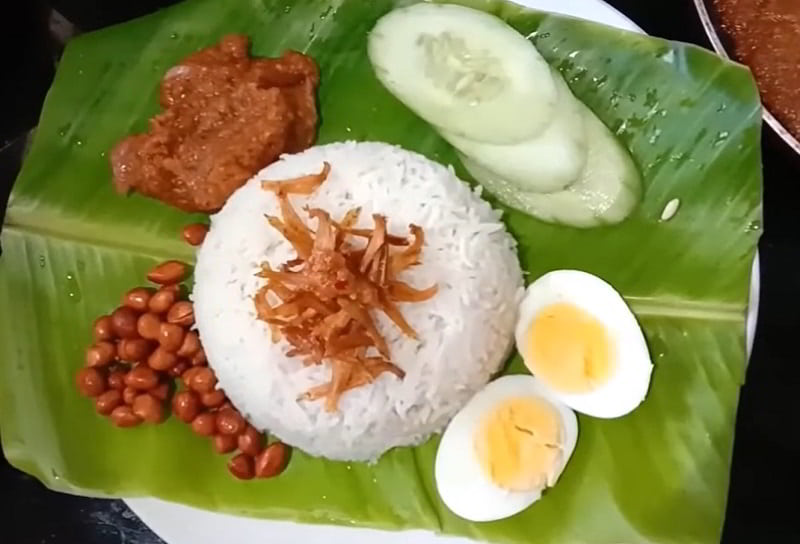
Nasi lemak, a quintessential Malay dish, tantalizes taste buds with its aromatic coconut-infused rice, cooked to creamy perfection with pandan leaves. Its name, translating to "rich rice," aptly captures its luxurious flavor. The dish's heart lies in its vibrant accompaniments: fiery sambal, a chili paste imbued with garlic and shrimp paste, delivers a spicy punch, while crispy anchovies and roasted peanuts provide delightful crunch. A hard-boiled or fried egg adds protein richness, harmonizing with the dish's creamy textures. Served alongside fresh cucumber slices, nasi lemak offers a refreshing respite from its bold flavors. This culinary symphony of sweet, spicy, and savory notes makes nasi lemak a beloved breakfast staple in Malaysia, though its allure transcends meal times.
Coconut Jam

Coconut jam, also known as "kaya", is a sweet and creamy spread made from sugar, coconut milk, eggs, and sometimes pandan leaves for flavoring. This delightful condiment boasts a rich and smooth texture with a luscious coconut flavor. To make coconut jam, coconut milk is gently simmered with sugar until it thickens, then eggs are added to create a custard-like consistency. The mixture is continuously stirred over low heat until it reaches the desired thickness and a caramelized aroma develops. Pandan leaves may be added during cooking to infuse the jam with a subtle fragrance and green hue. Coconut jam is commonly enjoyed spread on toast or crackers for breakfast or as a snack. It can also be used as a filling for pastries or cakes, adding a tropical twist to baked goods.
Rojak
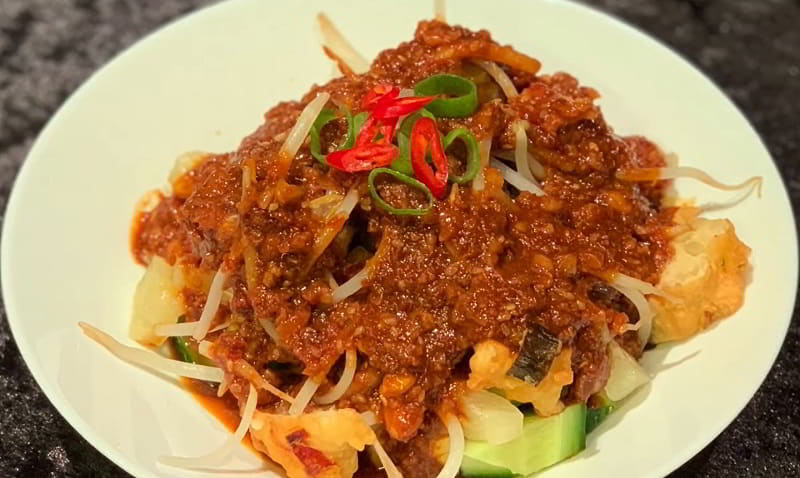
Rojak, a widely appreciated salad, stands out for its distinctive blend of flavors and textures. The prevalent version across Malaysia, Indonesia, and Singapore features a medley of sliced fruits and vegetables accompanied by a zesty palm sugar dressing. Renowned as a tangy and spicy fruit salad, the dressing encompasses a delightful combination of sweetness, heat, and spice derived from ground chili, palm sugar, and peanuts. Indonesian cuisine offers diverse preparations of rojak, with variations extending beyond fruits and vegetables. Prawn paste frequently contributes to the sweet and tangy dressing, adding depth to the flavor profile. Some recipes even incorporate seafood or meat elements, showcasing the versatility of this beloved dish throughout the region.
Dodol
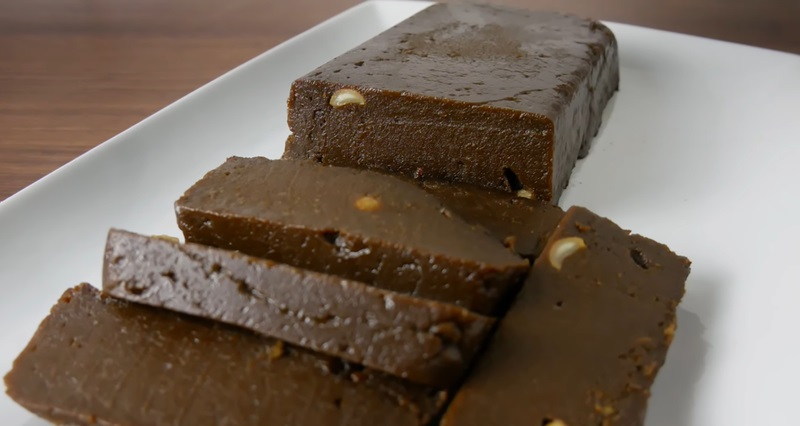
Dodol is a rich and sticky dessert made from a combination of coconut milk, palm sugar, and glutinous rice flour. The dish is cooked slowly over low heat, stirring continuously until it thickens and becomes a dense and chewy consistency. Dodol is often flavored with various ingredients such as pandan leaves, durian, or peanuts, adding a unique taste and texture to the dish. It is typically served in small bite-sized portions, wrapped in banana leaves or paper. This delicacy is commonly enjoyed during festive occasions and special celebrations, such as Eid al-Fitr and Chinese New Year. It is also a popular souvenir for tourists visiting Malaysia. The taste of dodol is a delightful blend of sweet, caramel-like flavors with a hint of coconut. Its sticky and chewy texture makes it a truly enjoyable treat.
Nasi Kerabu
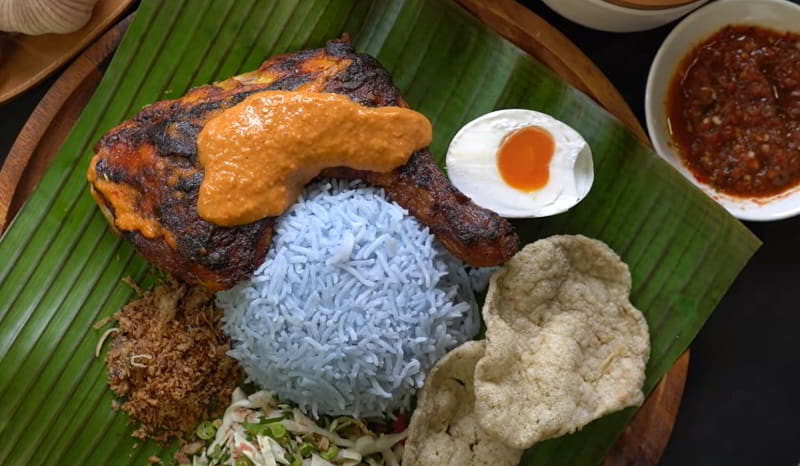
Nasi kerabu, a Malaysian rice delicacy belonging to the nasi ulam family, features vibrant blue-hued rice served alongside dried fish or crispy fried chicken, crackers, assorted pickles, and salads. The distinctive blue color of the rice is derived from the petals of Clitoria ternatea, commonly known as butterfly-pea flowers or bunga telang, which serve as a natural food coloring during the cooking process. Alternatively, the rice may be prepared using turmeric for a golden-yellow hue or served plain white. Accompaniments often include solok lada, stuffed peppers, and fried keropok, enhancing the meal's flavors and textures. Nasi kerabu offers a sensory journey through Malaysia's culinary landscape, celebrated for its visual appeal and diverse palate of flavors.
Lontong
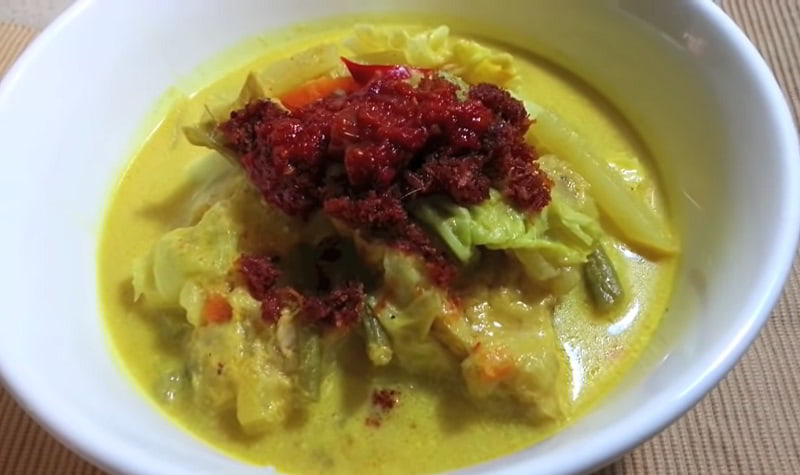
Lontong, a cherished rice dish, boasts a distinctive fusion of flavors and textures. This traditional delicacy comprises compressed rice cakes, meticulously cooked until achieving a firm consistency, and then artfully sliced into bite-sized pieces. The rice cakes are thoughtfully enveloped in banana leaves, imparting a unique aroma and flavor to the dish. Lontong stands as a versatile accompaniment, often served alongside various dishes like gado-gado, ketoprak, and karedok, enhancing the overall culinary experience with its delectable combination of tender rice cakes and the aromatic essence derived from the banana leaves.
Curry Puff

Curry puff, also known as karipap, is a popular snack that is loved for its delicious flavors and crispy texture. It is a small, savory pastry filled with a fragrant and spicy curry mixture. The pastry shell is made from a combination of flour, butter, and water, creating a flaky and golden crust when deep-fried. The filling of the curry puff is what truly makes it irresistible. It typically consists of potatoes, onions, carrots, and chicken or beef, all cooked in a blend of aromatic spices such as curry powder, turmeric, and cumin. The filling is simmered until tender and infused with the rich flavors of the spices. Curry puffs are often enjoyed as a snack or appetizer, perfect for on-the-go eating. They can be found in many Malay food stalls and are commonly served with a side of spicy chili sauce for an extra kick. The combination of the crispy pastry and flavorful curry filling creates a mouthwatering experience that satisfies both the savory and spicy cravings.
Banana Fritter
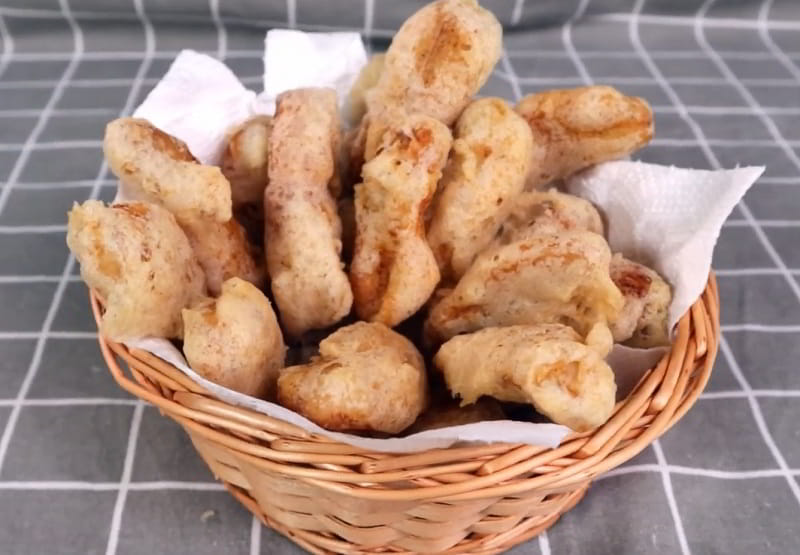
Malay cuisine is known for its rich and diverse flavors, and one delicious dish that showcases this is the banana fritter, also known as Pisang Goreng. This traditional Malay sweet treat is a delightful combination of ripe bananas coated in a batter and deep-fried to perfection. To make banana fritters, ripe bananas are sliced and dipped in a batter made of flour, sugar, and a hint of spices like cinnamon or cardamom. The bananas are then fried until golden brown, resulting in a crispy exterior that contrasts with the soft and sweet interior. The aroma of the banana fritters wafts through the air, enticing anyone nearby with its mouthwatering scent. Served hot, these fritters are often enjoyed as a snack or dessert.
Bubur Cha Cha
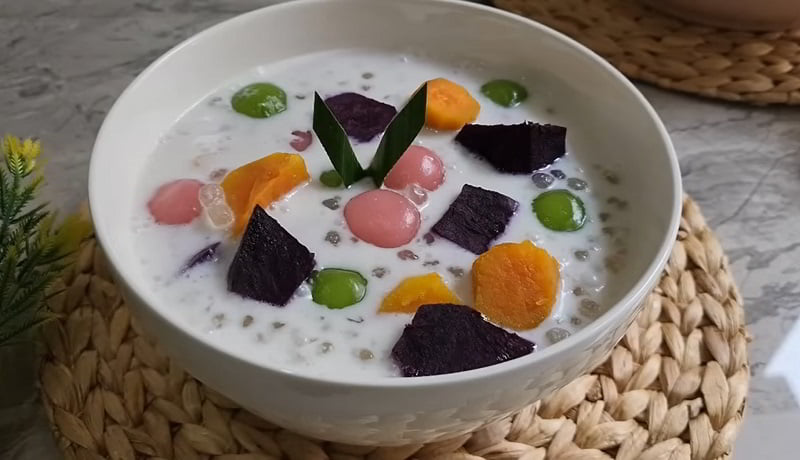
Bubur Cha Cha is a celebrated dessert known for its vibrant hues and delightful taste. The traditional recipe features coconut milk, pearled sago, bananas, sweet potatoes, yams, sugar, pandan leaves, and a touch of salt. Additional richness is introduced by incorporating grated coconut, coconut cream, and water. The key to this sweet creation lies in cooking these ingredients harmoniously in coconut milk, offering a luscious texture. Bubur Cha Cha can be relished either hot or cold, making it a versatile and refreshing treat. With its array of colorful ingredients and a coconut-infused base, Bubur Cha Cha stands out as a beloved dessert, embodying the rich and diverse flavors of Malay culinary traditions.
Kuih
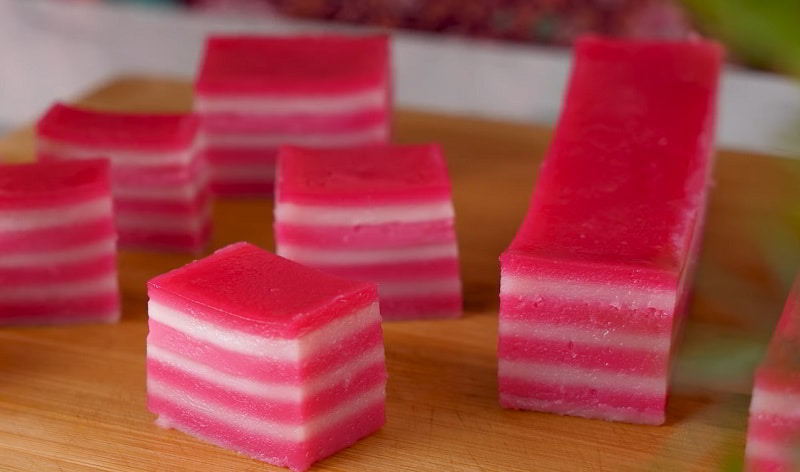
Kuih is a type of traditional Malay dessert that comes in various shapes, colors, and flavors. It is commonly served during special occasions, festivals, and as a tea-time snack. Made from a combination of rice flour, coconut milk, and palm sugar, Kuih has a soft and chewy texture that is both satisfying and indulgent. The ingredients used in Kuih can vary depending on the region and personal preference, resulting in a wide variety of flavors such as pandan, coconut, and banana. Kuih is often steamed or baked, resulting in a delightful aroma that fills the air. The vibrant colors and intricate designs of Kuih make it visually appealing, adding to its overall appeal. It is usually served in small bite-sized portions, making it easy to enjoy and perfect for sharing. Whether it is the classic Kuih Lapis, the aromatic Kuih Dadar, or the sweet and sticky Kuih Seri Muka, Malay Kuih is a delightful treat that embodies the rich cultural heritage and culinary traditions of Malaysia.
Ketupat
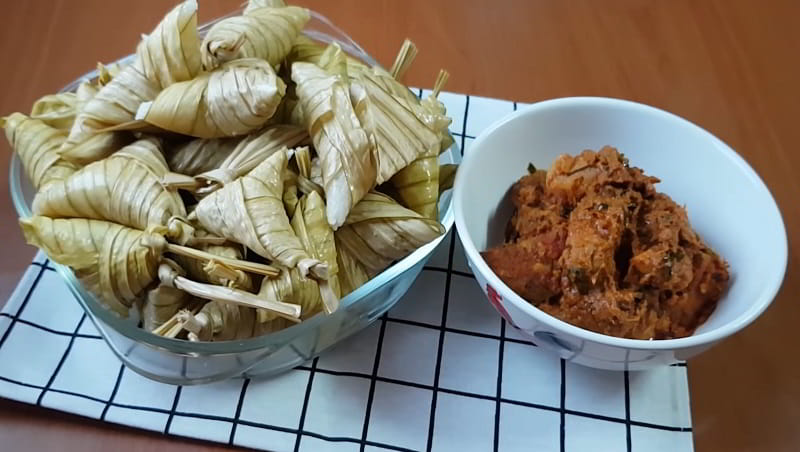
Ketupat is a delectable dish that is made from glutinous rice wrapped in coconut leaves and then boiled. This dish is commonly served during festive occasions such as Hari Raya Aidilfitri and Hari Raya Aidiladha. To make ketupat, the glutinous rice is first soaked in water for a few hours and then drained. The rice is then packed tightly into a diamond-shaped pouch made from coconut leaves. The pouch is then boiled in water for several hours until the rice is fully cooked. The coconut leaves not only give the ketupat its distinct shape but also infuse the rice with a subtle aroma. Ketupat is typically served with various types of meat dishes such as rendang, satay, or curry. The texture of the rice is soft and sticky, which pairs well with the bold flavors of the accompanying dishes. The coconut leaves also impart a slight sweetness to the rice, enhancing its overall taste.
Tharid
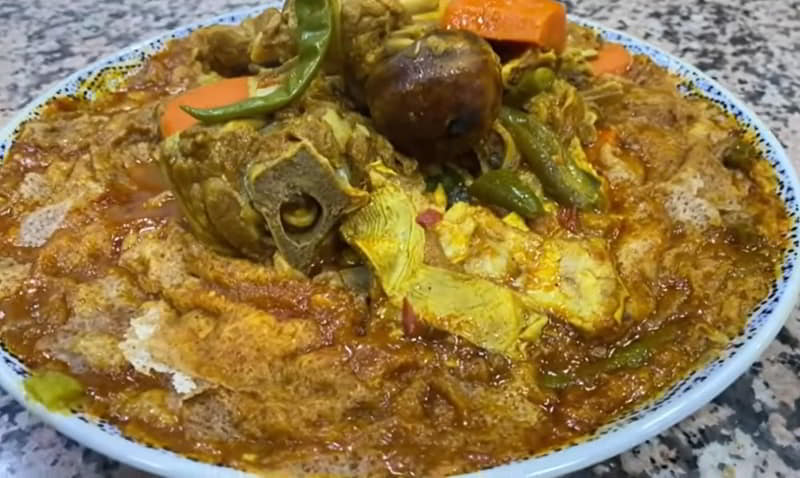
Tharid, originally an Arabian dish, has made its mark in Malay cuisine with its rich and aromatic flavors. This bread soup is celebrated for its simplicity, consisting of broth and crumbled flatbread, creating a delightful combination of textures and tastes. The unique blend of moistened flatbread with flavorful broth or stew is a testament to the cultural exchange and culinary diversity that has enriched Malay cuisine. Tharid stands out as a comforting and hearty dish, showcasing the harmonious fusion of Arabian influences with the distinctive flavors of the Malay culinary tradition.
Sata
-1708340480.jpg)
Sata is a traditional dish that hails from the East Coast of Malaysia, particularly from the state of Terengganu. It is a delectable seafood dish that is loved by locals and visitors alike. Sata is made by marinating pieces of fish, usually sardines, in a mixture of ground spices such as turmeric, ginger, garlic, and lemongrass. The marinated fish is then wrapped in banana leaves and grilled over an open fire, giving it a smoky and aromatic flavor. The banana leaves not only add a wonderful fragrance to the dish but also help to keep the fish moist and tender. The resulting Sata is a delightful combination of flavors, with the spices infusing the fish with a tangy and slightly spicy taste. It is often served as an appetizer or as a part of a larger seafood feast. Sata is best enjoyed when accompanied by steamed rice and a spicy dipping sauce made from chili, lime juice, and soy sauce.
Acar

Acar is a delectable pickle that showcases an array of vegetables and fruits, forming a visually appealing and enticing creation. Primary ingredients encompass cucumbers, carrots, shallots, and pineapple, while variations may include additions like cabbage and bell peppers. The vegetables undergo precision slicing before being immersed in a pickling concoction of vinegar, sugar, and an array of spices. Noteworthy spices such as turmeric, ginger, and chili impart the distinct taste that defines acar. Through the pickling process, the vegetables absorb the spice-infused flavors, resulting in a tantalizingly tangy and subtly spicy dish. Acar finds its place as a versatile side dish or condiment, enhancing the overall dining experience when paired with main courses. Its refreshing essence provides the perfect counterpoint to rich and savory dishes, contributing a burst of flavor and crunch. Beyond its culinary appeal, acar is a nutritious option, delivering essential vitamins and fiber from its vegetable components.
Roti John

Roti John is a unique variation of a sandwich that is typically made with a baguette or French loaf. The bread is usually sliced lengthwise and filled with a flavorful mixture of minced meat, onions, eggs, and various spices. The filling is then pan-fried until golden brown and crispy. The key to a tasty Roti John lies in the combination of ingredients and spices used in the filling. The minced meat, often chicken or beef, is typically seasoned with spices like garlic, ginger, and cumin. The onions add a sweet and savory flavor while the eggs help bind the mixture together. Roti John is often served with a side of chili sauce or mayonnaise, adding a tangy and creamy element to the dish. It is commonly enjoyed as a street food or quick snack, but can also be served as a main course.
Budu
-1708089845.jpg)
Budu is a beloved sauce in that is highly popular in the east coast states of Malaysia, particularly Kelantan and Terengganu. It is made from fermented anchovies, known locally as ikan bilis, and salt. This unique sauce has a pungent and salty flavor, making it a distinctive condiment in Malay cooking. To prepare Budu, the anchovies are washed and then mixed with salt in a tightly sealed container. The mixture is left to ferment for several months, allowing the anchovies to break down and release their flavors. During the fermentation process, the sauce develops a deep umami taste and a dark brown color. Budu is commonly used as a dipping sauce for grilled or steamed seafood, such as grilled fish or prawns. It adds a distinct tangy and savory flavor to the dishes, enhancing their taste. Due to its strong aroma and taste, Budu may not be for everyone, but for those who appreciate bold and unique flavors, it is a must-try sauce.
Mee Goreng
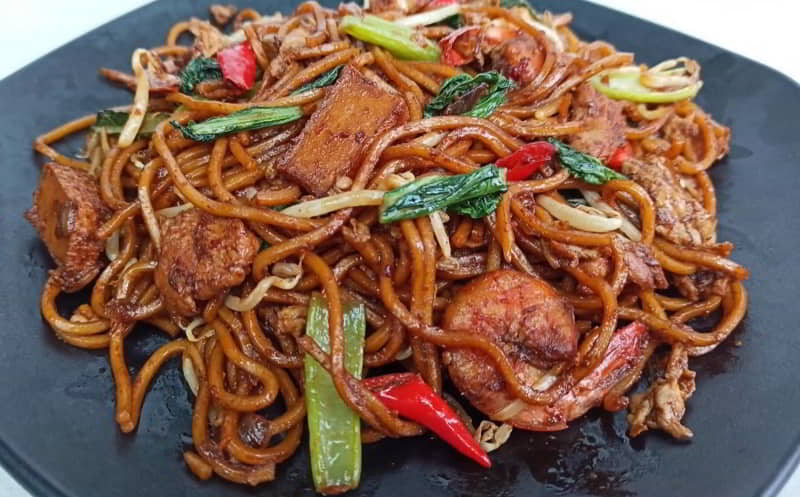
Mee goreng, also known as mi goreng, encompasses fried noodles popular in Malay-speaking regions across multiple countries. One noteworthy rendition, mee goreng mamak, originates from Mamak stalls run by Muslim Indian communities, renowned for their fiery flavor profiles. The term "mamak," derived from the Tamil word for maternal uncle, serves as a respectful address for shopkeepers or eatery owners in Malaysia and Singapore. Mee goreng mamak epitomizes the fusion of Chinese yellow noodles with the aromatic seasonings and spices characteristic of Malay and Indian culinary traditions. Another variant, Maggi mee goreng, adapts the Mamak-style mee goreng using Maggi brand instant noodles, first prepared with hot water before stir-frying, offering a convenient twist to this beloved dish.
Nasi Dagang
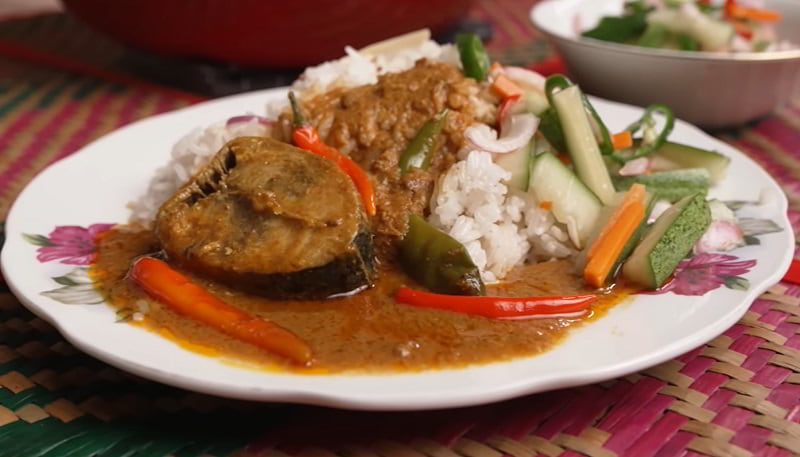
Nasi dagang is a flavorful and aromatic dish that consists of steamed rice cooked with coconut milk and served with a side of fish curry and condiments. The rice used in nasi dagang is a special type called glutinous rice, which gives it a sticky and slightly chewy texture. The rice is cooked with coconut milk, giving it a rich and creamy taste that complements the savory flavors of the fish curry. The fish curry is the highlight of this dish, typically made with fresh fish, spices, and herbs such as lemongrass and turmeric. The curry is cooked until it thickens and the flavors meld together, creating a fragrant and delicious sauce. Nasi dagang is usually served with various condiments such as sliced cucumber, pickled vegetables, and hard-boiled eggs. These condiments provide a refreshing and tangy contrast to the rich flavors of the rice and curry.
Soto Ayam
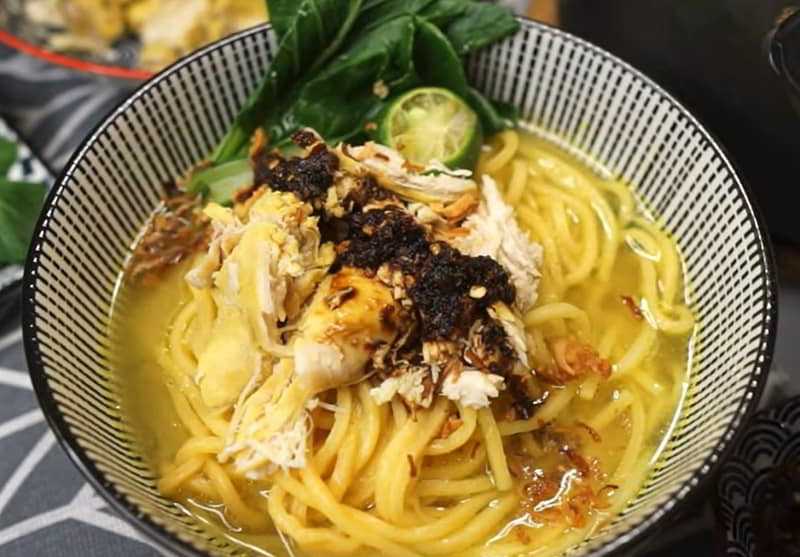
Soto ayam, a cherished Indonesian dish, boasts a flavorful broth infused with chicken, lontong (compressed rice cake), noodles, and rice vermicelli. Widely enjoyed in Singapore, Malaysia, and Suriname, this dish features a golden hue thanks to the addition of turmeric, a key ingredient in the chicken broth. It stands as one of the most beloved variations of soto, a traditional Indonesian soup. Alongside chicken and vermicelli, it may be accompanied by slices of fried potatoes, hard-boiled eggs, and Chinese celery leaves, with fried shallots often used as a garnish. Coconut milk adds richness to the broth, while toppings like koya (a mix of prawn crackers and fried garlic) or sambal provide additional depth of flavor. Krupuk (crackers) or emping are common toppings, with lalapan served as a customary side dish.
Mee Bandung
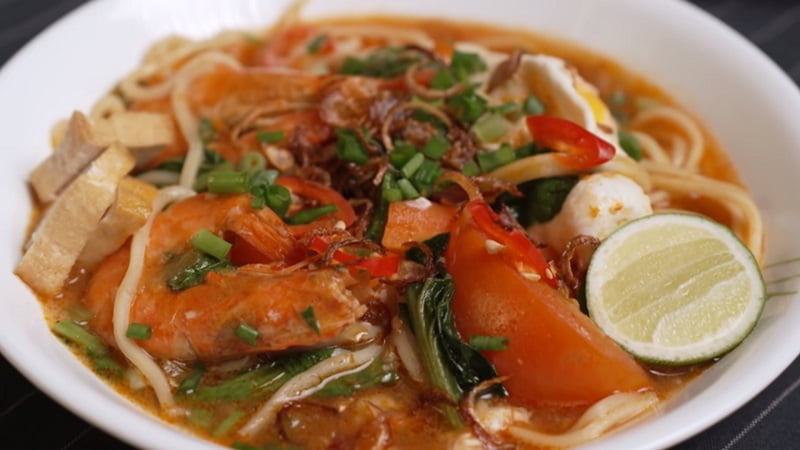
Mee Bandung is a flavorful noodle dish is known for its rich and spicy taste. The dish consists of yellow noodles cooked in a thick and aromatic gravy made from a blend of spices, dried shrimp, chili paste, and tamarind juice. The gravy is then further enhanced with ingredients such as shrimp, beef, and vegetables like bean sprouts and cabbage. Mee Bandung is typically garnished with fried onions, chopped scallions, and a squeeze of lime for a refreshing tang. The combination of the savory, spicy, and tangy flavors creates a mouthwatering experience that is unique to this dish. The noodles are tender and soak up the flavors of the gravy, making each bite a delight. Mee Bandung is often enjoyed as a hearty lunch or dinner and is a favorite among locals and tourists alike. Its origins can be traced back to the Malay community in Johor, where it has become a beloved part of their culinary heritage.
Nasi Ambeng
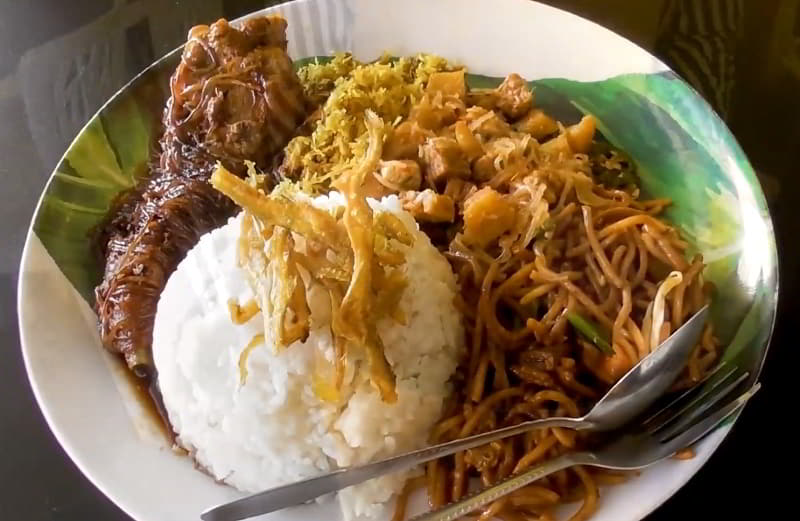
Nasi ambeng presents a delightful array of flavors in a fragrant rice ensemble, featuring steamed white rice as its base complemented by an assortment of dishes. These include sambal goreng (a mildly spicy stir-fried relish often comprising firm tofu, tempeh, and long beans), chicken curry or chicken simmered in soy sauce, bergedel (potato patties), beef or chicken rendang, urap (vegetables mixed with grated coconut), and serunding (spiced meat floss). This hearty and aromatic dish offers a symphony of tastes and textures, reflecting the diverse culinary heritage of Indonesia. While these components form the core of nasi ambeng, variations may include additional accompaniments, enriching the dining experience with each bite.
Tempoyak
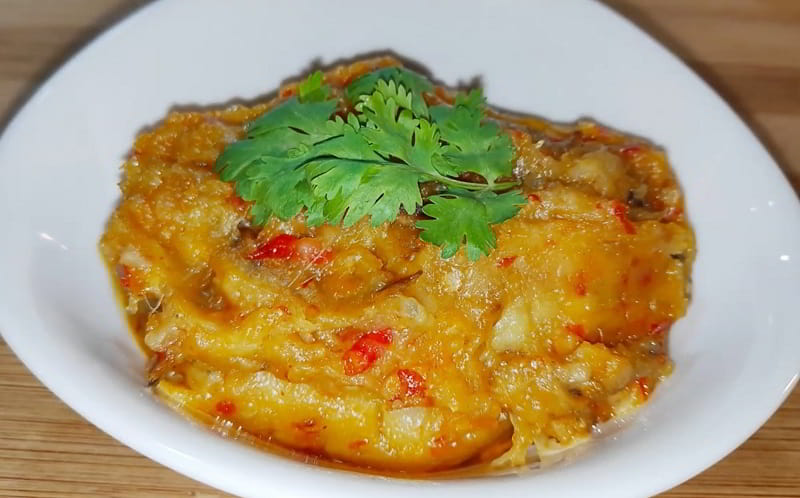
Tempoyak, a culinary gem, stands out for its distinct and robust flavors, crafted from fermented durian, a tropical delight native to Southeast Asia. The preparation involves extracting durian flesh and blending it with salt, chili, and an assortment of spices, resulting in a luscious and tangy paste. This amalgamation is left to ferment, a process spanning several days, allowing the flavors to mature and intensify. The resulting paste carries a pungent aroma and a subtly sour taste. Tempoyak often takes center stage in dishes featuring various vegetables and protein sources like fish or prawns. During the cooking process, the paste is introduced, imparting its unique flavor profile to the entire dish. Typically served with steamed rice, Tempoyak creates a delightful interplay, allowing its complex flavors to harmonize with the simplicity of rice. Treasured by Malaysians, Tempoyak captures the essence of durian, a fruit cherished and revered in Southeast Asia. Its bold tanginess and richness make Tempoyak an unforgettable culinary experience for those fortunate enough to savor its unique allure.
Pie Tee
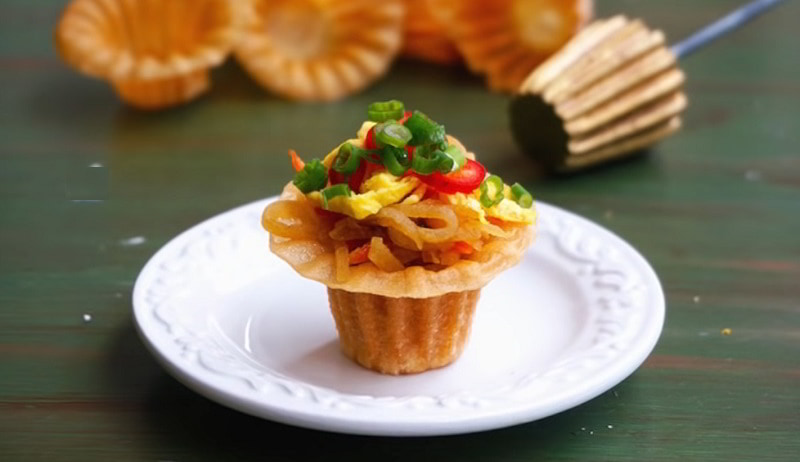
Kueh Pie Tee delights with its delicate, crispy pastry tart shells, typically filled with a flavorful mixture of spicy shredded Chinese turnips, sweet vegetables, and prawns. These thin shells, crafted from flour, can be readily found in most supermarkets, although some establishments prepare them from scratch. Resembling popiah in composition, the primary filling comprises shredded jicama and carrots, often sold alongside each other at hawker stalls in bustling centers. The harmonious blend of savory and sweet flavors, coupled with the satisfying crunch of the pastry, makes Kueh Pie Tee a beloved treat in Southeast Asian cuisine. While the traditional recipe includes these key ingredients, variations may exist, adding diversity to this beloved snack enjoyed by many.
Cincalok
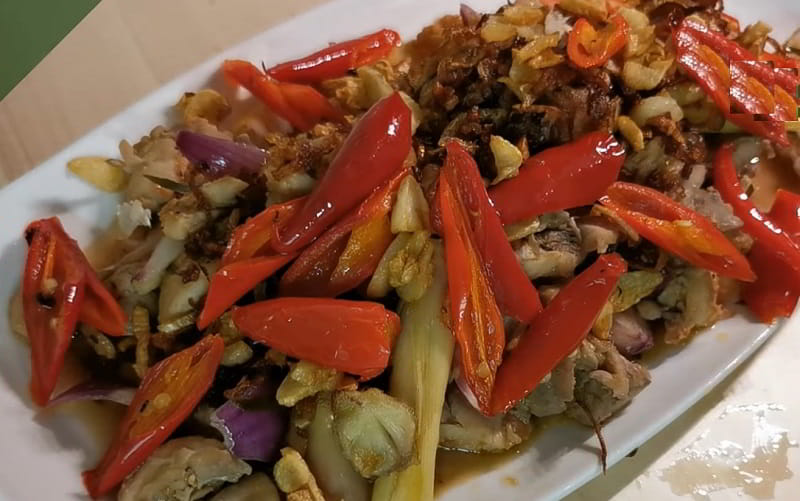
Cincalok, or cencaluk, emerges as a distinctive Malay condiment hailing from Malacca, Malaysia. Crafting cincalok involves a meticulous process. Fresh small prawns (udang geragau) are meticulously combined with equal parts salt and rice. Once thoroughly mixed, the blend is sealed in a jar, left to ferment for three days. Some cincalok artisans opt to increase the rice proportion, convinced it enriches the final flavor profile. This artisanal approach yields a tangy, pungent condiment cherished for its unique taste and culinary versatility. With its origins deeply rooted in Malaysian heritage, cincalok adds depth and complexity to a range of dishes, embodying the rich tapestry of flavors found in Southeast Asian cuisine.
Asam Pedas
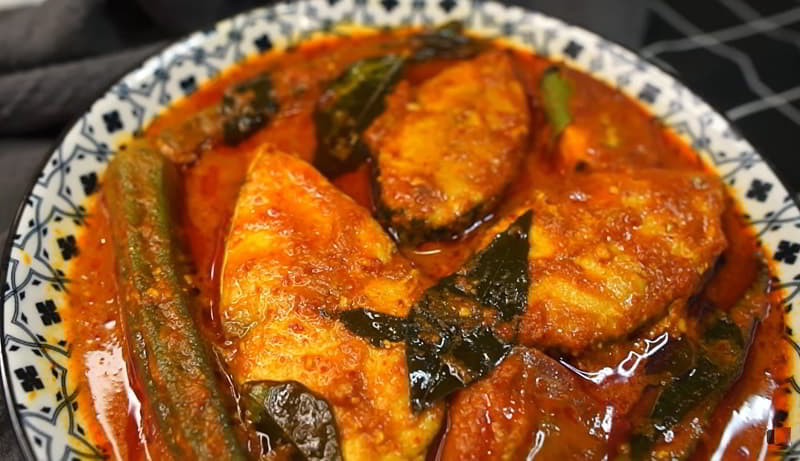
Asam pedas, a signature dish of Maritime Southeast Asia, is a tangy and spicy fish stew celebrated for its vibrant flavors. Typically, seafood or freshwater fish take center stage in this dish, simmered in a tantalizing broth crafted from tamarind juice, chili, and an array of spices. To prepare, the tamarind pulp is softened before its juice is extracted for cooking. Alternatively, asam paste can be used for convenience. Complementing the seafood are vegetables such as terong (Indian eggplants), okra, and tomatoes. Popular fish and seafood options range from mackerel to red snapper or cuttlefish, either whole or in parts, ensuring a bold and flavorful stew. Care is taken to preserve the fish's integrity, often adding it towards the end of the cooking process. Asam pedas epitomizes the culinary diversity and richness of the region, offering a delightful symphony of tastes and textures.
Ikan Bakar
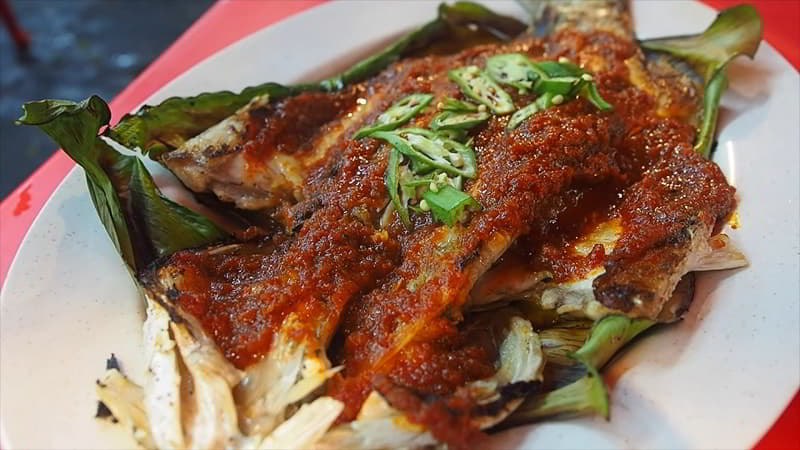
Ikan bakar is a dish that is loved by many seafood enthusiasts. The term "ikan bakar" translates to "grilled fish" in English, and it perfectly describes the cooking method used for this delicious dish. To prepare ikan bakar, a fresh whole fish, usually a firm-fleshed fish like mackerel or snapper, is marinated in a mixture of spices and herbs. The marinade typically includes ingredients like sweet soy sauce, turmeric, ginger, garlic, lemongrass, and chili, which give the fish a flavorful and aromatic profile. Once marinated, the fish is then grilled over an open flame or charcoal, which imparts a smoky and slightly charred flavor to the flesh. The grilling process also creates a crispy outer layer while keeping the interior moist and tender. Ikan bakar is often served with a side of sambal, a spicy chili paste, and a squeeze of lime for added zest. The combination of the grilled fish with the spicy sambal and tangy lime creates a perfect balance of flavors. This dish is commonly enjoyed with steamed rice and a variety of other side dishes like grilled vegetables or pickles.
Bahulu
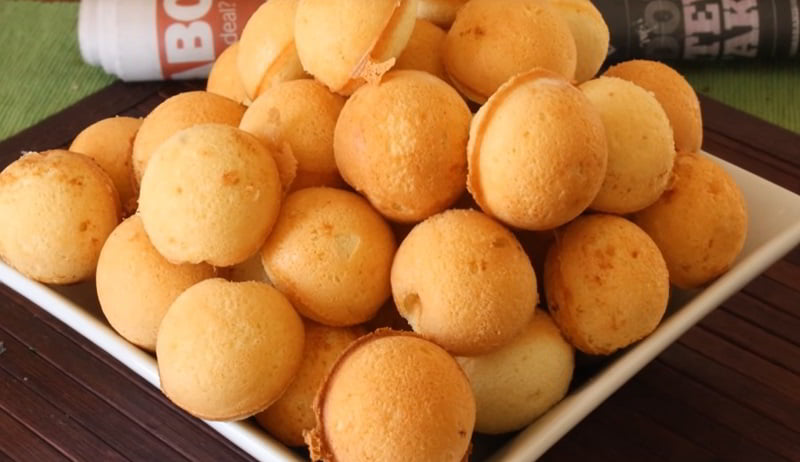
Bahulu, a beloved Malay pastry (kue/kuih), shares similarities with the madeleine cake but boasts a distinctive round shape and unique ingredients. This traditional delight is available in three variations: the commonly found bahulu cermai (star-shaped), as well as the less common bahulu gulung (roll-shaped) and bahulu lapis (layered). Traditionally enjoyed during Eid al-Fitr and the Lunar New Year, bahulu enchants with its soft texture and delicate sweetness, making it a cherished treat during festive celebrations. Whether served alongside tea or as a delightful snack on its own, bahulu embodies the rich culinary heritage of Malaysia, delighting generations with its timeless flavors and cultural significance.
Akok
-1708108201.jpg)
Akok is a delectable kuih enjoyed as a snack or dessert, featuring sugar, eggs, flour, and coconut milk in its ingredients. It comes in two main variants, with the Terengganu version incorporating the basic ingredients, and the Kelantan variant adding brown sugar or palm sugar for a darker hue. The Kelantan version tends to be less fluffy than its counterpart. Akok boasts a sweet profile with a rich, eggy aftertaste, but a savory twist called akok berlauk introduces chili peppers, minced meat, curry powder, and fried onions as a filling. Traditionally, akok is baked in a brass mould over smouldering coconut charcoal, imparting a distinctive smoky flavor and aroma, akin to the preparation of bahulu.
Bihun Goreng
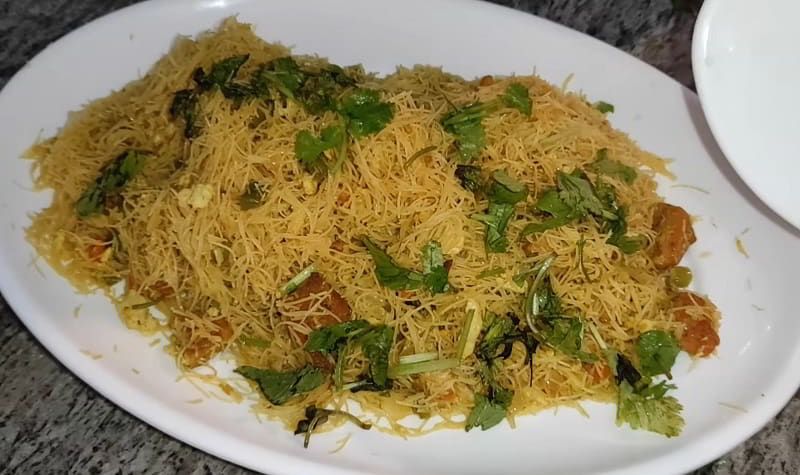
Bihun goreng is a popular dish, featuring stir-fried rice noodles which are cooked with an array of ingredients to create a mouthwatering and satisfying meal. The key ingredients of bihun goreng typically include bihun noodles, vegetables such as carrots, cabbage, and bean sprouts, protein sources like chicken, shrimp, or tofu, and a variety of seasonings and sauces. These seasonings often include soy sauce, oyster sauce, garlic, and chili paste, which lend a balance of savory, tangy, and spicy flavors to the dish. To prepare bihun goreng, the noodles are soaked in hot water until they are softened, and then stir-fried with the other ingredients in a wok or frying pan. The result is a fragrant and flavorful dish that can be enjoyed on its own or accompanied by a side of pickles or sambal, a spicy chili condiment. Bihun goreng is a versatile dish that can be customized to suit individual preferences.
Lemang
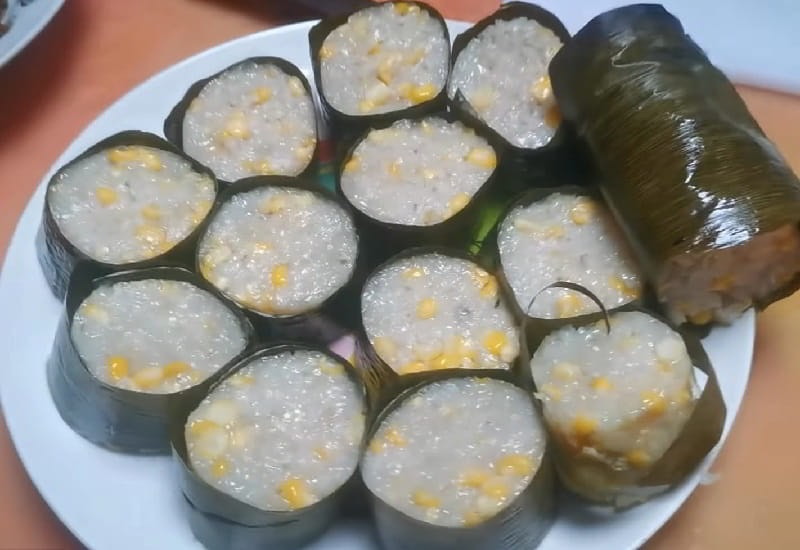
Lemang is a type of glutinous rice dish that is cooked in bamboo tubes, giving it a unique flavor and texture. Lemang is typically prepared during festive occasions such as Hari Raya Aidilfitri, weddings, and other special events. To make lemang, the bamboo tubes are lined with banana leaves and filled with a mixture of glutinous rice and coconut milk. The filled tubes are then placed over an open fire or in an underground pit, allowing the rice to cook slowly and absorb the smoky fragrance from the bamboo. This traditional cooking method gives the lemang a distinct earthy taste and a slightly chewy texture. Once cooked, the bamboo tubes are carefully cracked open, revealing the perfectly steamed and aromatic lemang inside. The lemang is then sliced into thick rounds and served with rendang, a flavorful meat dish made with spices and coconut milk. Lemang is loved for its rich and fragrant taste, making it a favorite among Malaysians during festive celebrations.
Ayam Buah Keluak
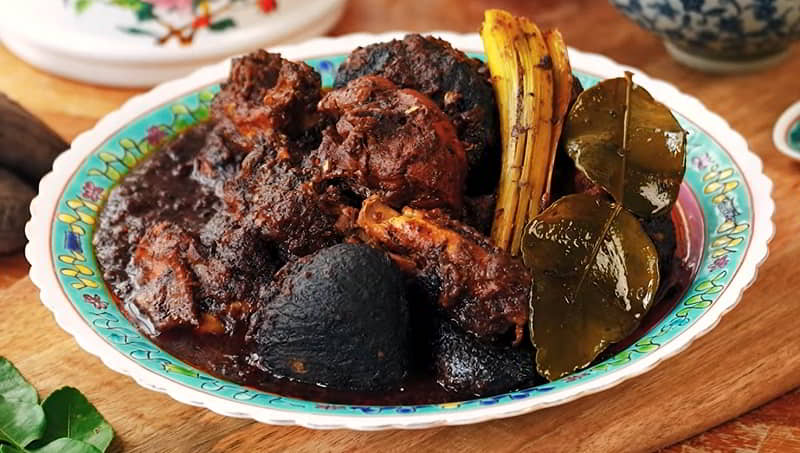
Ayam buah keluak is a flavorsome dish that features chicken cooked with buah keluak, a type of nut that is native to Southeast Asia. The buah keluak nuts are boiled and fermented for several days to remove their toxicity before being cracked open and the flesh inside is extracted. The chicken is first marinated with a blend of spices and then simmered in a rich and aromatic gravy made from ground buah keluak flesh, tamarind juice, and various herbs and spices. The result is a thick and velvety sauce with a distinctly earthy and nutty flavor. The dish is typically served with steamed rice and accompanied by a variety of condiments such as sambal belacan (spicy shrimp paste), cucumber slices, and fried shallots. Ayam buah keluak is a labor-intensive dish that requires patience and skill to prepare, but the end result is a truly unique and satisfying culinary experience that showcases the depth and complexity of Malay cuisine.
Roti Jala
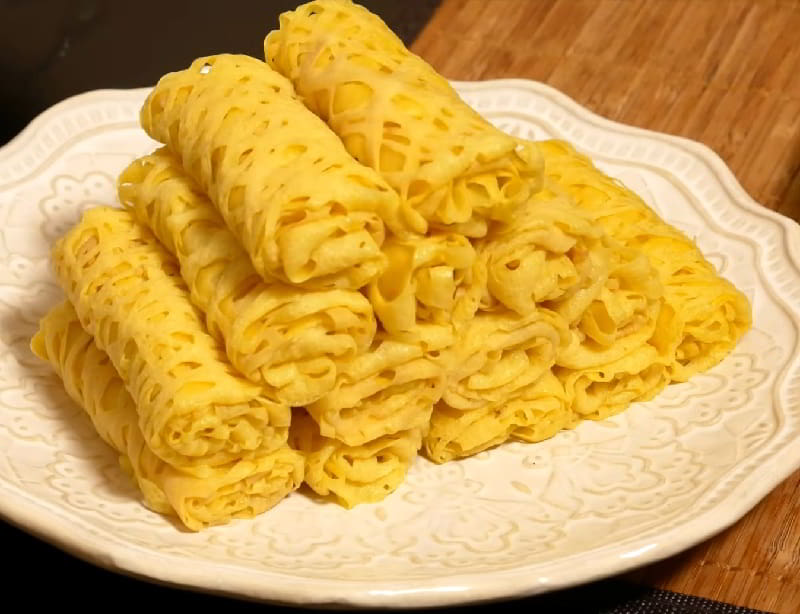
Roti jala, a culinary delight known as "net bread," graces tables with its intricate lace-patterned pancakes. The batter, a blend of flour, eggs, coconut milk, and a hint of turmeric, is skillfully dispensed through a specialized funnel onto a hot, greased skillet. The circular motion of drizzling creates mesmerizing patterns, resulting in a beautiful net-like texture upon cooking. Renowned for its soft, slightly sweet taste, roti jala serves as a perfect companion to rich curries or gravies, offering a sublime flavor balance. These thin and delicate pancakes, easily rolled or folded, become exquisite vessels for soaking up delectable sauces, enhancing the overall dining experience. Beyond its gastronomic appeal, roti jala presents a visual feast with its intricate patterns and golden hue, adding an alluring touch to any meal.
Pindang
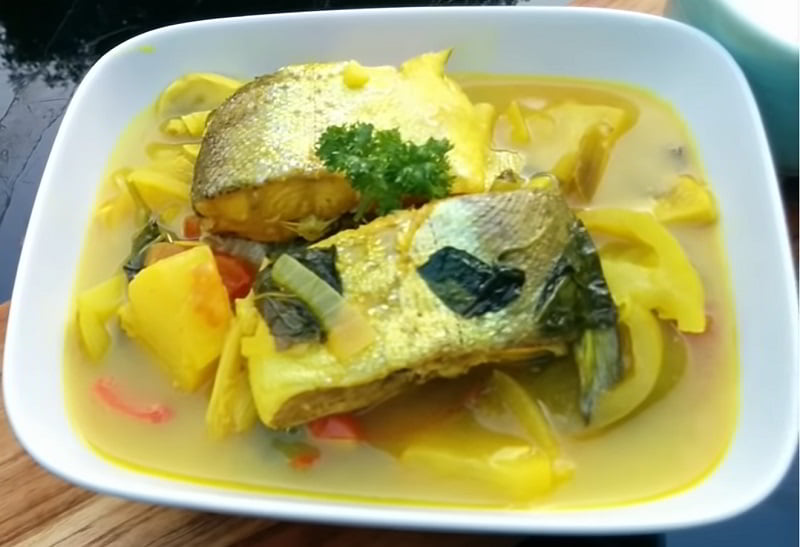
Pindang, a flavorful fish soup, boasts a distinctive taste derived from a blend of spices and herbs. Typically, freshwater fish like catfish, carp, ikan patin, or gourami serve as the base for pindang. However, seafood such as grouper, milkfish, mackerel, tuna, red snapper, or shrimp can also be used. The cleaned fish flesh is boiled in a broth infused with various spices, including tamarind juice, citrus leaf, garlic, lemongrass, shallot, ginger, daun salam (Indonesian bay leaf), turmeric, galangal, shrimp paste, chili pepper, palm sugar, and salt. The soup is further enriched with tomato, pieces of chili pepper, lemon basil, cucumber, and pineapple. Pindang offers a pronounced sourness balanced with a mild sweetness and gentle spiciness, creating a harmonious flavor profile that tantalizes the taste buds.
Nasi Ulam
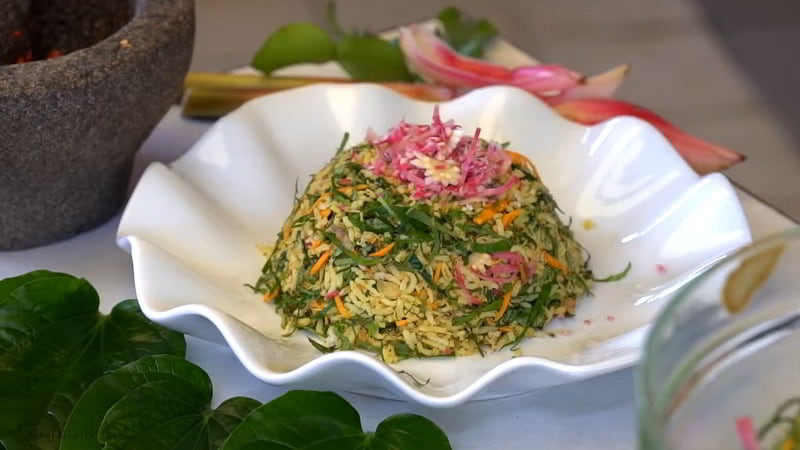
Nasi ulam is an aromatic rice creation that involves the blending of steamed rice with an array of finely chopped herbs, vegetables, and spices. At the heart of nasi ulam lies ulam, a medley of local herbs such as daun kaduk (wild pepper leaf) and pucuk gajus (cashew leaf shoots), renowned for their distinctive flavors and reputed medicinal properties. In the meticulous preparation of nasi ulam, these herbs are finely chopped and seamlessly integrated into the rice. Complementary ingredients like shredded coconut, dried shrimp, toasted grated coconut, and fried shallots are added to impart an additional layer of texture and flavor. Served alongside a spicy sambal, a chili paste featuring chili peppers, shrimp paste, and lime juice, nasi ulam becomes a delightful ensemble of tastes.
Ulam
-1708111510.jpg)
Ulam is essentially a salad that features a variety of raw vegetables, herbs, and sometimes fruits. Ulam typically includes a combination of leafy greens such as lettuce and spinach, along with herbs like mint, basil, and cilantro. It is also common to find slices of cucumber, bean sprouts, and shredded carrots in the mix. To add a touch of sweetness, thinly sliced fruits like mango or pineapple are sometimes incorporated. The dressing for ulam is usually a simple concoction of lime juice, fish sauce, and chili, giving it a tangy and spicy kick. This dressing perfectly complements the freshness of the vegetables, creating a harmonious blend of flavors. Ulam is not only delicious but also highly nutritious, as it provides a great source of vitamins, fiber, and antioxidants. It is often served as a side dish or as an accompaniment to main meals, adding a refreshing and healthy element to the overall dining experience.
Telur Pindang
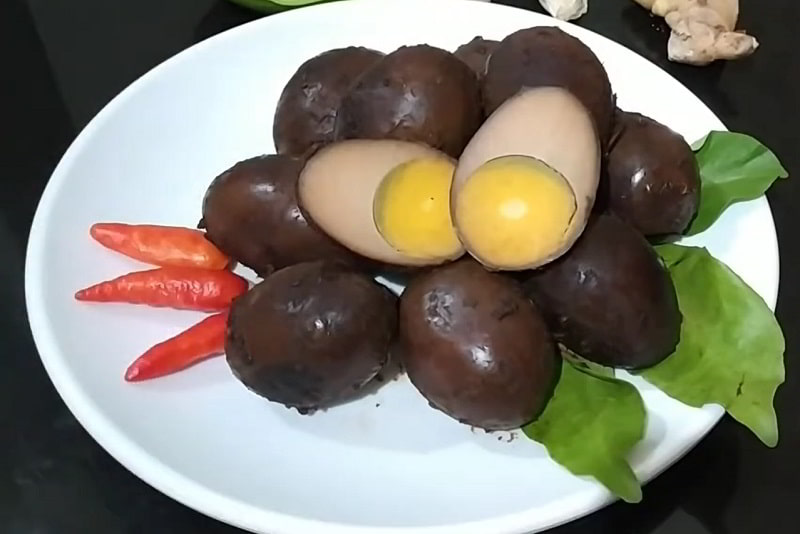
Telur pindang, or pindang eggs, is a Javanese culinary delight originating from Indonesia, notably popular in Malay and Palembang cuisines. This dish features hard-boiled eggs subjected to the pindang process, where they are slowly boiled in a mixture of shallot skins, water, teak leaf, salt, soy sauce, and various spices. While bearing resemblance to Chinese tea eggs, telur pindang sets itself apart by employing unique coloring agents such as leftover shallot skins, teak or guava leaves, resulting in a distinctive dark brownish hue. This culinary practice highlights the regional diversity and cultural influences that contribute to the rich tapestry of Indonesian and Malay gastronomy.
Pekasam
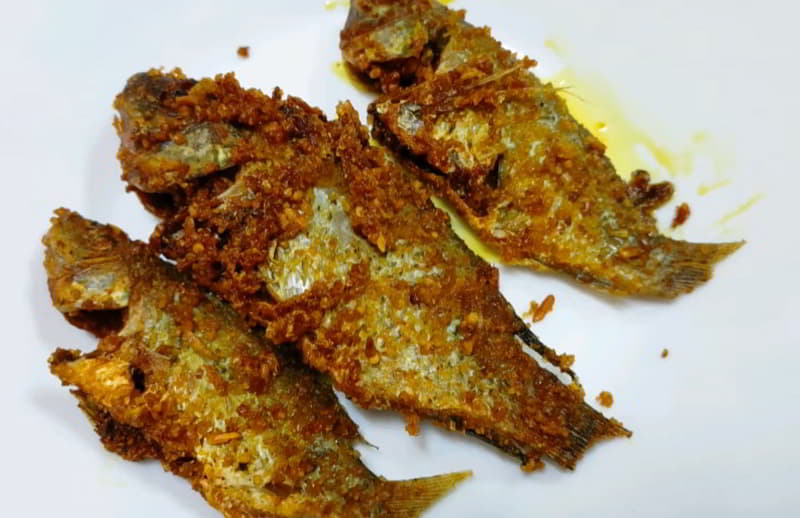
Pekasam, also known as Pakasam or Bekasam, is a term in Malay cuisine denoting fermented food, particularly fermented fish products. In Malay and Banjar culinary traditions, pekasam typically entails freshwater fish undergoing fermentation with a mixture of salt, palm sugar, toasted rice grains, and pieces of asam gelugur. Through this process, the fish develops a distinctive tangy flavor profile, enriched by the savory notes of salt and the subtle sweetness of palm sugar. The addition of toasted rice grains adds depth and texture to the dish, while asam gelugur contributes a sour element, enhancing the overall complexity of flavors. Pekasam serves as a beloved component of traditional Malay cuisine, offering a unique taste experience that reflects the region's rich culinary heritage.
Jemput-jemput
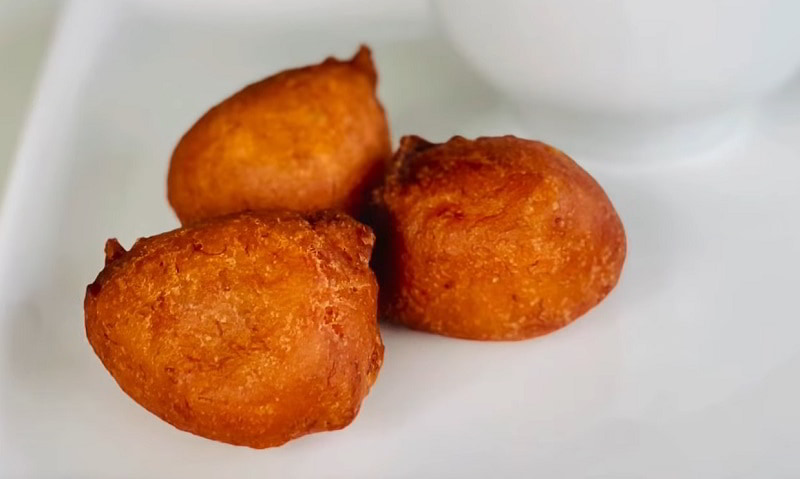
Jemput-jemput is a beloved snack, recognized for its fritter-like qualities, making it a popular choice for appetizers or tea-time indulgence. Typically round in shape, these snacks come in various sizes and boast diverse variations. Some renditions feature bananas, providing a sweet twist, while others incorporate anchovies or prawns, along with the savory addition of onion or maize. The versatility of jemput-jemput showcases the creativity and adaptability inherent in Malay culinary traditions, allowing for a range of delightful flavors and textures to cater to different preferences and occasions. Whether enjoyed as a delightful snack or a flavorful appetizer, jemput-jemput continues to be a cherished and versatile dish.
Sup Kambing
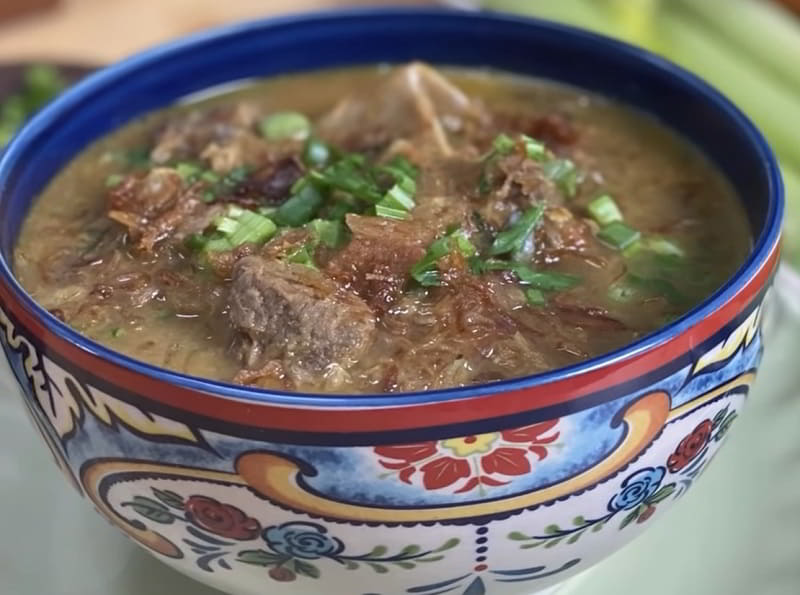
Sup kambing is a popular mutton soup that is made with tender chunks of mutton, cooked in a fragrant blend of spices and herbs. The key ingredients in sup kambing include mutton, onions, garlic, ginger, and a variety of aromatic spices such as cinnamon, cloves, and cardamom. These ingredients are combined to create a flavorful broth that is further enhanced with the addition of vegetables like carrots, potatoes, and cabbage. Sup kambing is often served with a side of rice, bread, or roti canai, making it a complete and satisfying meal. The dish is enjoyed for its tender and succulent mutton, which is cooked to perfection in the flavorful broth. The spices and herbs used in the dish add depth and complexity to the overall flavor profile, making sup kambing a truly delightful and comforting food choice.
Mee Siput
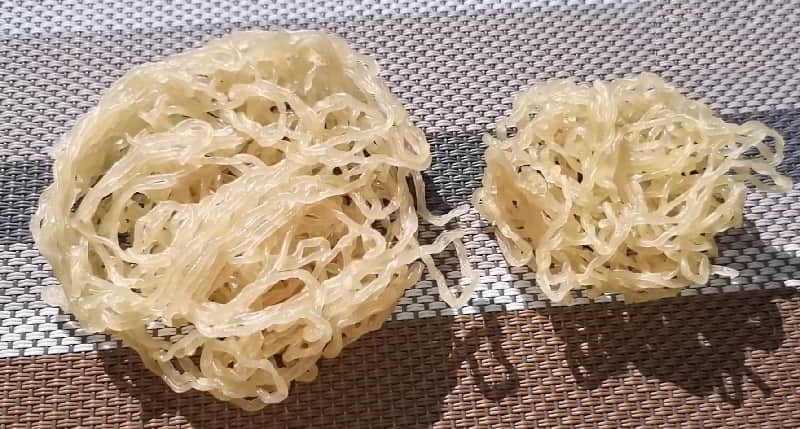
Mee Siput Muar, also known simply as Mee Siput, stands out as a distinctive cracker originating from Muar, Johor, Malaysia. Crafted traditionally by hand, this cracker is meticulously prepared using flour dough, rolled into extended noodle-like strips, and then artfully swirled into a circular spiral pattern, resembling the shell of a siput or snail in Malay. Following a sun-drying process, the Mee Siput undergoes deep-frying in cooking oil, resulting in a delightful crispiness. This ready-to-eat snack is ideally paired with condiments like chili soy sauce, sambal, and/or chili paste. Beyond its unique appearance resembling a snail shell, the Mee Siput offers a crispy texture that evokes the delicate and brittle feeling associated with a snail shell when savored.
Kerisik

Kerisik plays a crucial role in Indonesian, Malaysian, and Singaporean culinary traditions. This coconut-based ingredient involves grating, toasting, and grinding coconut into a paste, sometimes known as coconut butter. It serves as a key element in various dishes like kerabu salads and rendang. Creating fresh kerisik involves grating and frying fresh coconut, followed by grinding in a mortar and pestle. While dried grated coconut can also be utilized, the resulting paste may lack the same aromatic quality. It's important to note that pre-made kerisik may acquire an undesirable odor over time, emphasizing the preference for freshly prepared variations. Whether made at home or purchased ready-made, kerisik enriches the flavors of diverse dishes, contributing to the distinctive taste of regional cuisines.
Seri Muka

Seri Muka is a delectable sweet treat is known for its vibrant colors and unique combination of flavors. The name "Seri Muka" translates to "radiant face" in Malay, which perfectly describes the delightful appearance of this dessert. Seri Muka consists of two layers - a sticky glutinous rice layer at the bottom and a smooth pandan custard layer on top. The base layer is made by steaming glutinous rice that has been infused with coconut milk, giving it a rich and creamy taste. The top layer is a pandan-flavored custard made from eggs, coconut milk, and pandan juice, which gives it a beautiful green hue and a fragrant aroma. The combination of the sweet, chewy glutinous rice and the creamy, pandan-infused custard creates a harmonious blend of flavors and textures. The dessert is often garnished with a sprinkle of grated coconut to add a hint of nuttiness.
Mie Bakso
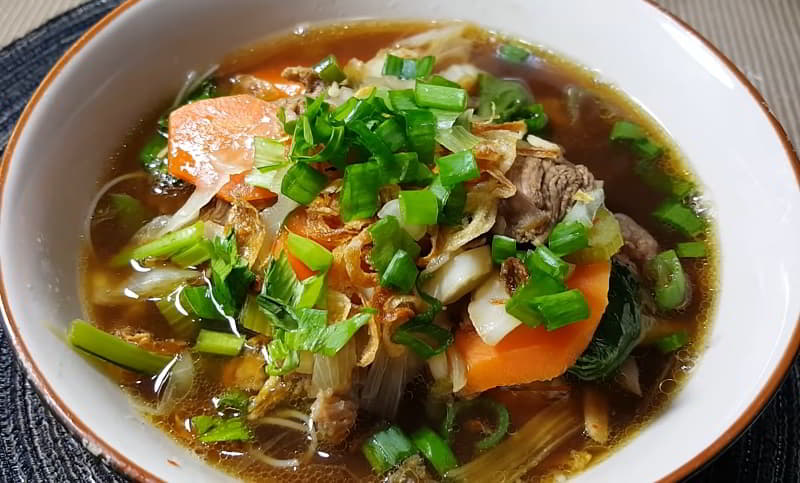
Mie bakso is a comforting and satisfying dish that is loved by many locals and tourists alike. The dish typically consists of egg noodles served in a flavorful broth, accompanied by an assortment of meatballs. The meatballs in mie bakso are made from a blend of minced beef and spices, giving them a delicious and savory taste. They are usually served with generous portions of sliced scallions, fried shallots, and a sprinkle of crispy crackers on top. Some variations of mie bakso also include additional ingredients such as tofu, fish cakes, or shrimp. The dish is commonly enjoyed as a hearty and filling meal, perfect for any time of the day. It is often served with a side of chili sauce or sambal for those who prefer a spicy kick.
Ayam Pansuh
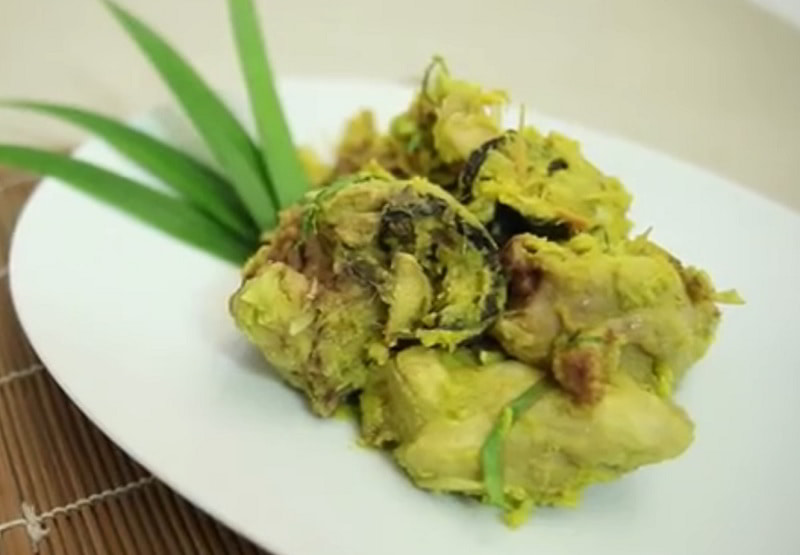
Ayam pansuh, also known as manuk pansuh, is a dish where chicken is cooked inside a bamboo stalk, creating a unique culinary experience. The bamboo is filled with water, which becomes the flavorful soup, along with seasonings. The preparation involves covering the bamboo with tapioca leaves from the cassava plant, which are later enjoyed alongside the cooked chicken. While the exact origin of ayam pansuh is unclear, it is a customary dish during festivals, particularly the Gawai Dayak festival, celebrated for a bountiful harvest. This traditional delight is notably cherished among the communities in Sarawak, Malaysia, and West Kalimantan, Indonesia, showcasing the regional diversity of this cultural culinary gem.
Nasi Lemuni
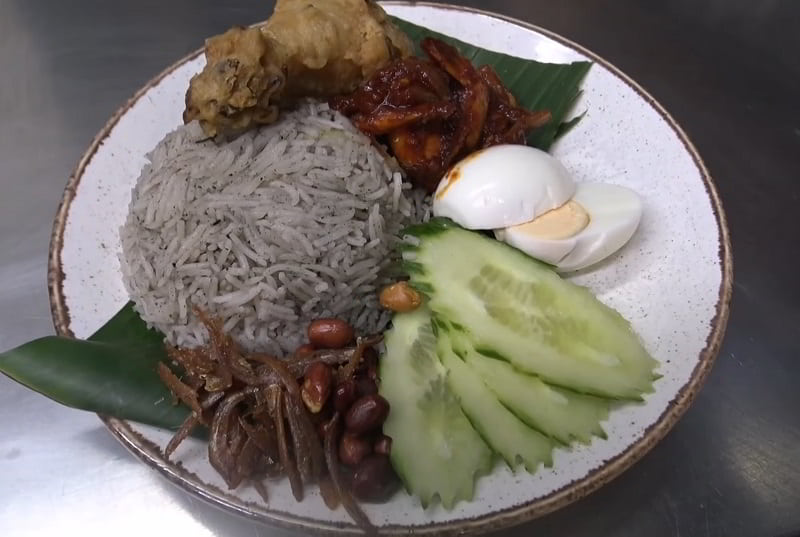
Nasi Lemuni is a delectable and aromatic dish that is prepared by cooking fragrant rice with various herbs and spices, giving it a distinct and appetizing flavor. The key ingredient in Nasi Lemuni is Lemuni leaves, which are unique to this dish. These leaves are known for their medicinal properties, as they are believed to have calming and soothing effects. They also impart a refreshing and herbal taste to the rice. The rice is cooked in coconut milk, which adds richness and creaminess to the dish. Accompanying the Nasi Lemuni are an assortment of side dishes that complement the flavors of the rice. These may include spiced fried chicken, sambal (a spicy shrimp paste), and vegetable dishes such as acar (pickled vegetables). The combination of the flavorful rice and the various side dishes creates a harmonious and satisfying meal.
Karas
-1708324018.jpg)
Karas, or Kuih Karas, stands out as a renowned traditional delicacy in Kedah, primarily found in the Kota Setar District. This delectable treat is ideal for tea time, paired perfectly with a steaming cup of coffee. Not limited to Kedah, Kuih Karas has also made its mark on Borneo Island, gracing the regions of Sabah, Sarawak, and Brunei. Crafted from rice flour, this cake boasts a distinctive net-like appearance, shaped using a specialized mold. Its delightful combination of sweetness and crunchiness adds to its charm, making Kuih Karas a beloved and iconic culinary delight in the cultural tapestry of these regions.
Kue Kochi
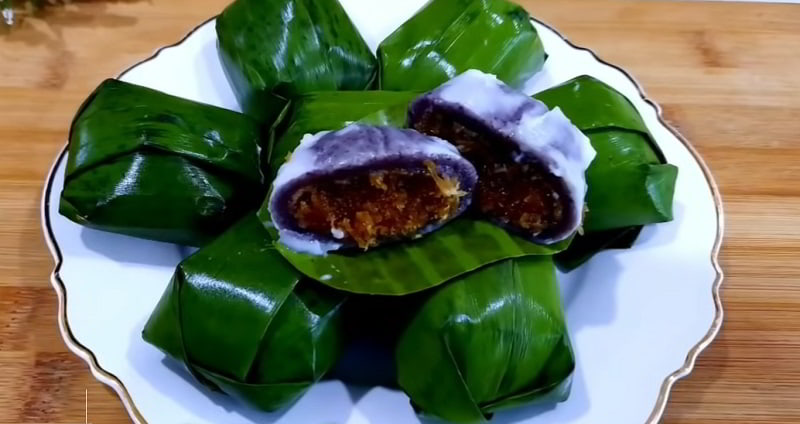
Kue Kochi is a mouth-watering snack made from glutinous rice flour and filled with a sweet and fragrant mixture of grated coconut, palm sugar, and pandan leaves. The dough is shaped into small balls and then steamed until it becomes soft and chewy. The combination of the sticky rice dough and the sweet coconut filling creates a delightful contrast in texture and flavor. The pandan leaves add a subtle aroma to the dish, enhancing its overall appeal. Kue Kochi is often served as a dessert or enjoyed as a snack with a cup of hot tea. This delectable treat is not only a crowd favorite during festive seasons and special occasions, but it is also a popular street food. Whether you have a sweet tooth or simply appreciate the rich flavors of coconut and palm sugar, Kue Kochi is sure to satisfy your cravings and leave you wanting more.
Pek Nga
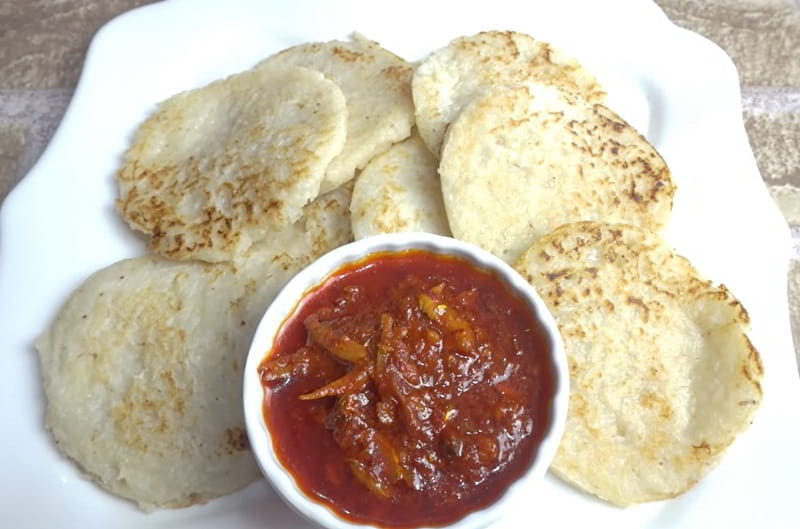
Pek nga, a beloved traditional Malaysian pancake, holds a unique position in the culinary heritage of Kedah, the northern state. Going by the name lempeng kelapa in the region of Kelantan and Terengganu, this pancake type has gained popularity that extends beyond regional borders. Typically savored during breakfast, Pek nga distinguishes itself with its versatility, pairing well with fish gulai, coconut sticky rice, or dried fish. Also referred to as lempeng kelapa, Pek nga emphasizes its widespread appeal, showcasing its regional significance. The pancake's flexibility in complementing various savory accompaniments solidifies its status as a preferred morning delicacy. Whether enjoyed with the savory richness of fish gulai, flavorful notes of dried fish, or the sweetness of coconut sticky rice, Pek nga embodies the diverse flavors contributing to the delightful breakfast experience in Malaysia.
Ringgi
-1708341558.jpg)
Ringgi, a distinctive traditional delicacy of Perlis, stands out as a unique culinary gem. This delectable treat is best enjoyed with a sprinkle of sugar and grated coconut, offering a delightful burst of flavors. A remarkable aspect of Ringgi is its versatility, as it also makes a delightful breakfast cereal when paired with buffalo milk. The interplay of sweetness and texture in Ringgi elevates its appeal, creating a memorable culinary experience. With its roots embedded in Perlis's culinary heritage, Ringgi has become a cherished and unique addition to the local gastronomic landscape, inviting individuals to savor the traditional flavors of this special treat.
Kue Kembang Goyang

Kue kembang goyang, also known as "shaking flower cake," is a traditional Malay delicacy that is loved for its unique shape and delightful taste. This beloved dish is often served during festive occasions and celebrations. The preparation of kue kembang goyang involves a simple batter made from rice flour, tapioca flour, eggs, and coconut milk. The batter is then poured into a special mold with a long handle and deep-fried until golden brown. The magic happens when the mold is shaken gently, causing the batter to create a beautiful flower-like shape that gives the cake its name. The crispy exterior of kue kembang goyang contrasts perfectly with the soft, chewy interior. It has a subtle sweetness that is enhanced by the fragrance of coconut milk. Some variations of this dish may also include pandan or rose flavors, adding an extra layer of aroma. Kue kembang goyang is often enjoyed as a snack or dessert, and it pairs well with a cup of hot tea or coffee.
Kue Semprit

Semprit, known as kue semprit in Indonesian and kuih semperit in Malay, is a beloved sweet snack in Southeast Asia. This delectable treat is crafted from a blend of custard powder, wheat flour, sugar, corn starch, and margarine, creating a luscious dough. The dough is skillfully rolled and cut into bite-sized pieces before being baked to a golden yellow perfection. Once cooled to room temperature, Semprit is ready to captivate palates with its delightful taste and texture. Renowned for its appeal, Semprit holds a special place, especially during Hari Raya celebrations, where its presence adds sweetness and joy to the festive occasions.
Kerutuk Daging
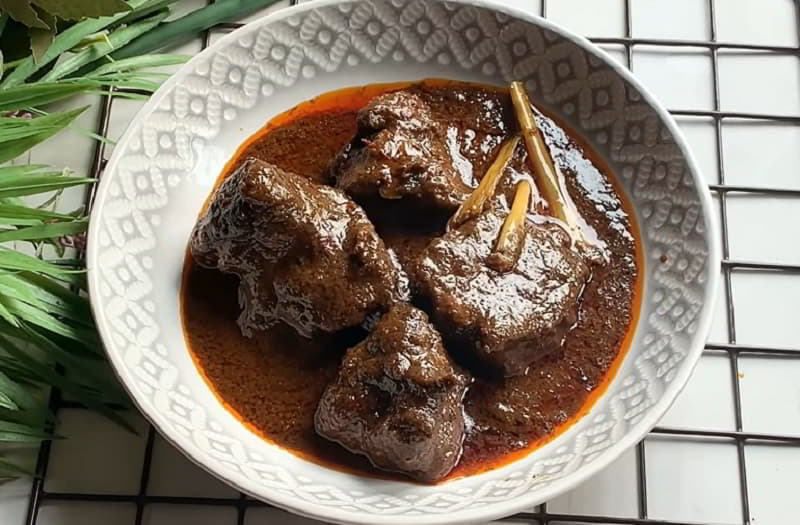
Kerutuk daging is a flavorsome dish that is typically made with tender chunks of meat, such as beef or mutton, cooked in a rich and spicy gravy. The dish is known for its unique blend of spices and herbs, which give it a distinct taste and aroma. The gravy is made with a combination of ingredients like lemongrass, galangal, turmeric, and coconut milk, which adds a creamy texture and enhances the flavors. Kerutuk daging is often served with steamed rice or bread, making it a hearty and satisfying meal. The tender meat absorbs the flavors of the spices, resulting in a delicious and savory dish that is loved by many. What sets Kerutuk daging apart is the use of toasted grated coconut, which is added to the gravy. This adds a nutty and slightly sweet taste to the dish, balancing out the spiciness and creating a harmonious blend of flavors.
Keria Gula Melaka

Keria gula melaka is a sweet potato doughnut-like fritter that is deep-fried until golden brown and crispy on the outside while remaining soft and fluffy on the inside. The key ingredient that gives this dish its unique flavor is gula melaka, which is palm sugar made from the sap of the coconut palm tree. To make keria gula melaka, sweet potatoes are mashed and mixed with flour and a pinch of salt to form a smooth dough. Then, small portions of the dough are shaped into round balls and deep-fried until they turn a beautiful golden color. Once fried, the keria balls are rolled in gula melaka syrup, which is made by melting the palm sugar with water and pandan leaves to create a rich and fragrant caramel-like coating. The combination of the soft and sweet potato dough with the sticky and aromatic gula melaka syrup creates a delightful balance of flavors. Keria gula melaka is often enjoyed as a tea-time snack or as a dessert after a satisfying meal.
Puding Diraja
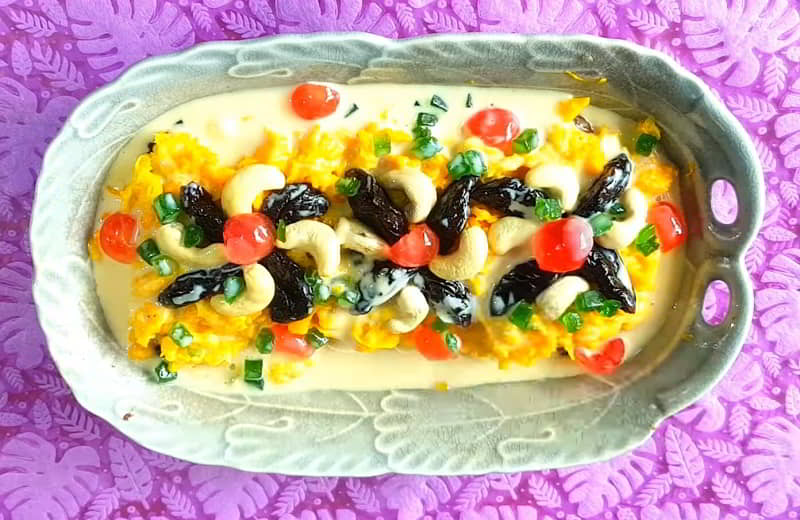
Puding Diraja, or Royal Pudding, is a distinguished dessert crafted exclusively for the royal family of Pahang, a Malaysian state. This regal treat boasts a harmonious blend of candied cherries, pisang lemak manis (a local banana cultivar), prunes, rich evaporated milk, and luscious cashew nuts. The pudding is adorned with the intricate design of jala mas and accompanied by a chilled sauce composed of milk and cornflour, enhancing its decadence. The careful selection and arrangement of ingredients reflect the esteemed status of this dessert, highlighting its royal pedigree and making it a delectable symbol of culinary sophistication in Pahang.
Nasi Beringin
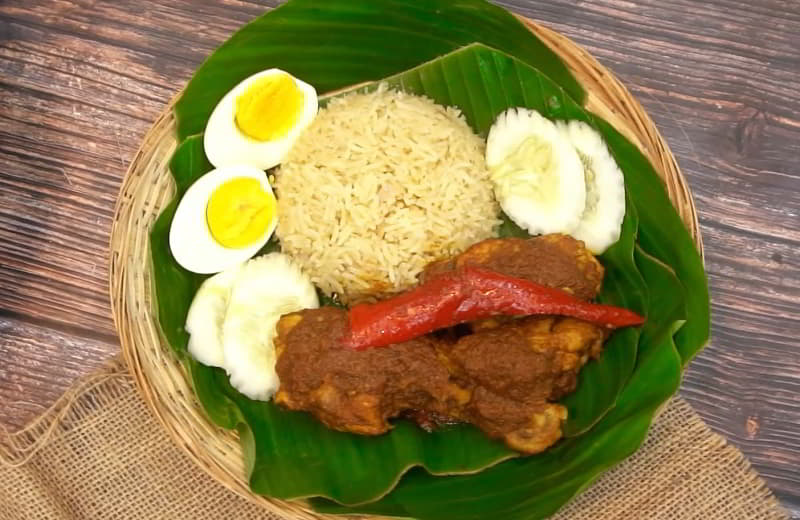
Nasi Beringin, a classic rice delicacy from Johor, Malaysia, holds rich historical significance, dating back to the late 1890s when it graced the tables of Johor royalties. Esteemed by sultans, the aromatic dish became a staple during royal gatherings in the palace. Typically accompanied by acar, chicken curry, sambal, and hard-boiled eggs, it offers a delightful culinary experience. Its versatility makes it a perfect choice for both breakfast and lunch, pleasing palates with a harmonious blend of flavors. This traditional dish not only reflects Johor's culinary heritage but also serves as a cultural emblem, embodying a legacy of royal indulgence and local gastronomic traditions.
Kuzi Ayam
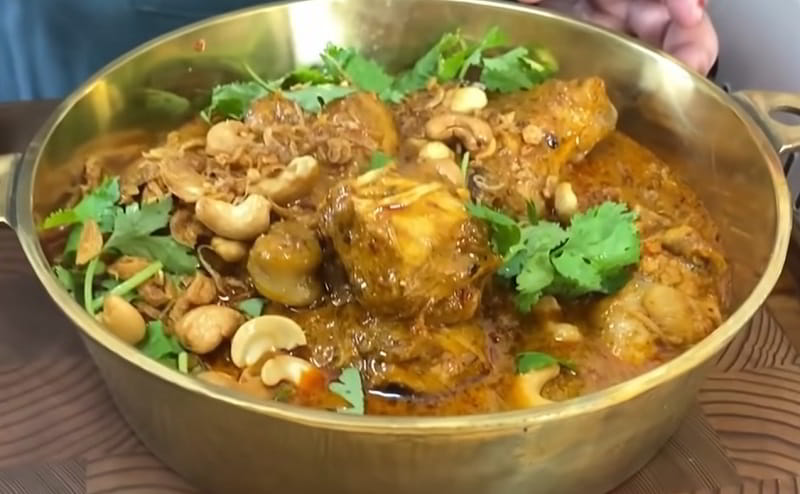
Nasi Beringin, a classic rice delicacy from Johor, Malaysia, holds rich historical significance, dating back to the late 1890s when it graced the tables of Johor royalties. Esteemed by sultans, the aromatic dish became a staple during royal gatherings in the palace. Typically accompanied by acar, chicken curry, sambal, and hard-boiled eggs, it offers a delightful culinary experience. Its versatility makes it a perfect choice for both breakfast and lunch, pleasing palates with a harmonious blend of flavors. This traditional dish not only reflects Johor's culinary heritage but also serves as a cultural emblem, embodying a legacy of royal indulgence and local gastronomic traditions.
Laksamana Mengamuk

Laksamana mengamuk, translated as 'raging admiral,' is a distinctive beverage originating from Riau, Indonesia. Comprising a blend of mango, coconut milk, and sugar, this refreshing drink carries a unique flavor profile. It has become a customary choice, often enjoyed during the month of Ramadan. The combination of sweet mango, rich coconut milk, and sugar creates a delightful harmony, offering a refreshing and indulgent experience, especially during the special occasions of Ramadan. Embraced for its tropical and sweet characteristics, Laksamana mengamuk not only provides a flavorful respite but also reflects the cultural and culinary richness of the Riau region in Indonesia. The drink's popularity during Ramadan adds a cultural dimension, making it a cherished part of festive celebrations in the local community.
Kue Pinyaram
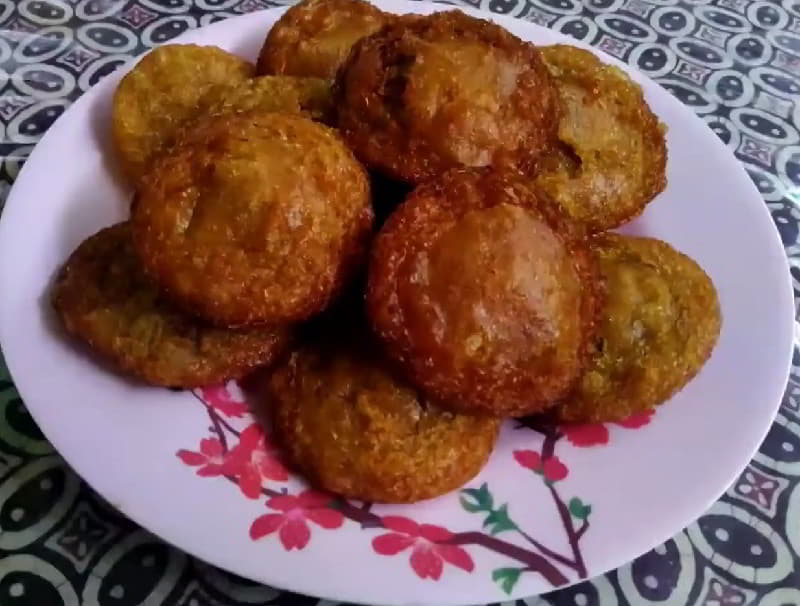
Pinyaram, also known as panyaram or penyaram, stands as a cherished traditional delicacy hailing from the Minangkabau culture in West Sumatra, Indonesia. This delectable treat takes center stage during special occasions such as weddings, Ramadan, and Eid al-Fitr. Over time, pinyaram has evolved into a distinctive Minangkabau souvenir. Crafted from a blend of white or palm sugar, white or black rice flour, and coconut milk, the cooking process closely resembles that of making pancakes. Pinyaram comes in two primary variants: pinyaram putih (white rice) and pinyaram hitam (black rice). However, contemporary versions have introduced vibrant colors to this traditional delight, showcasing the dynamic nature of this beloved Minangkabau treat.
Kebebe
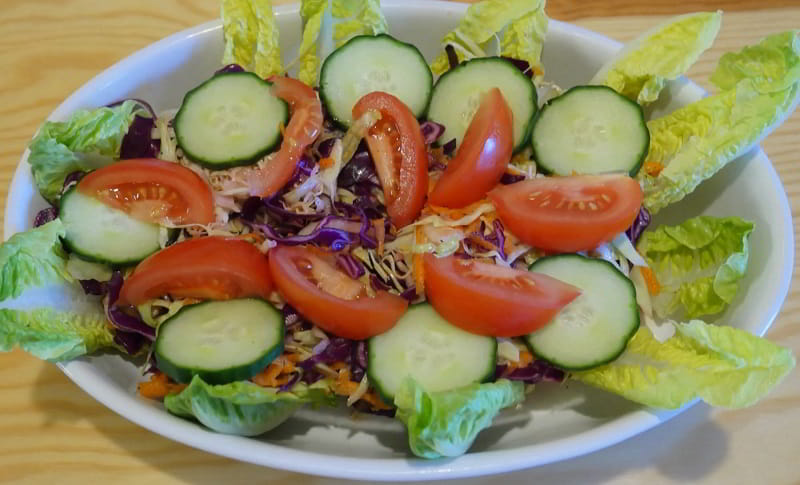
Kebebe, a traditional salad hailing from Lenggong, Perak, Malaysia, holds a special place in the culinary traditions of the region. Typically gracing the tables of traditional wedding feasts, it serves a dual role as both a dessert and a delightful companion during afternoon tea with hot beverages. This fruit salad boasts a rich medley of flavors and textures, featuring ingredients such as banana flower, bird's eye chili, leatherback bamboo, cermai, kelempong, cedong, jackfruit, guava, pineapple, and coconut. Its distinctive taste is enhanced by a dressing of belacan, sugar, and salt, creating a harmonious blend of sweet, savory, and spicy notes. Beyond its culinary appeal, kebebe is believed to have digestive benefits, reputedly capable of alleviating nausea after indulging in an excess of food. With its diverse ingredients and multifaceted flavors, kebebe embodies the cultural and gastronomic richness of Perak, providing a unique and satisfying culinary experience.
Apam Johol
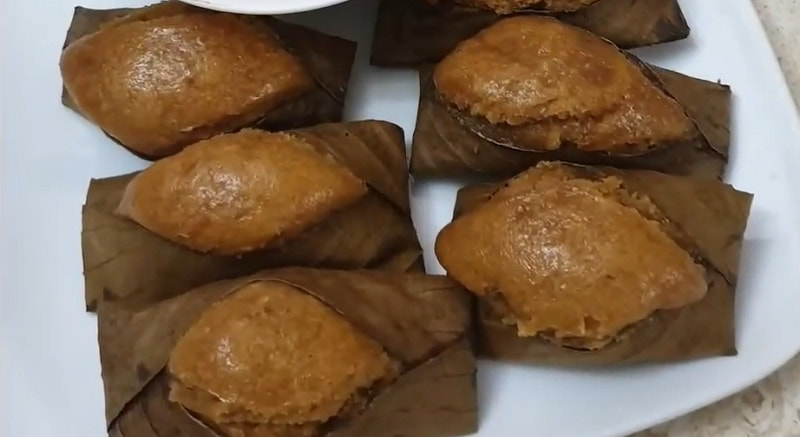
Apam Johol, also known as apam daun rambai, stands as a beloved traditional sweetened rice cake originating from Negeri Sembilan, Malaysia. This delectable treat is uniquely wrapped in rambai leaves, not only to retain its enticing aroma but also to enhance its visual appeal. Often enjoyed with rendang, sambal tumis, and bean porridge, Apam Johol offers a delightful culinary experience. Its preferred serving times include breakfast or teatime, making it a versatile and cherished dish in Negeri Sembilan's gastronomic heritage. The combination of sweetened rice cake, fragrant rambai leaves, and flavorful accompaniments reflects the region's culinary artistry and cultural richness, creating a treat that satisfies both the senses and the palate.
Laksa
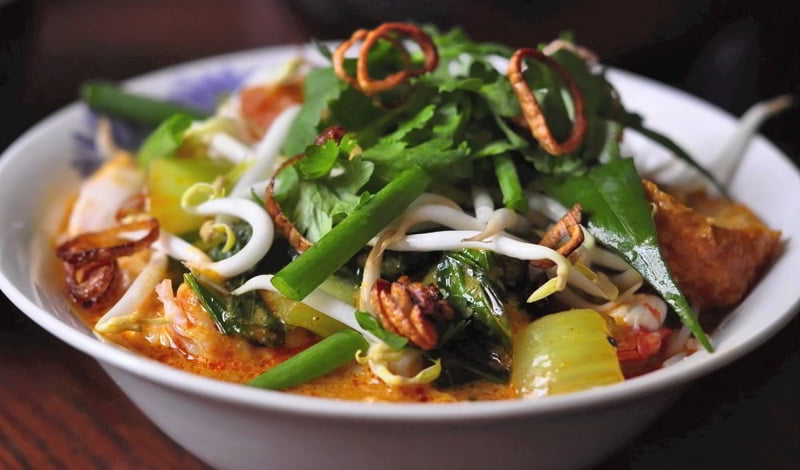
Laksa is a noodle soup dish that combines Chinese and Malay culinary influences, resulting in a unique and delicious blend. The dish typically consists of thick rice noodles, cooked in a spicy and tangy broth made with a base of coconut milk and various spices. The broth is the star of the dish, as it is packed with flavors from ingredients such as lemongrass, ginger, galangal, and chili. It is then enhanced with shrimp paste, tamarind, and lime juice, giving it a distinctive tangy and slightly sour taste. The soup is often filled with an array of ingredients, such as shrimp or prawns, fish cakes, bean sprouts, and tofu puffs, adding texture and variety to each bite. Laksa is often garnished with fresh herbs like coriander and mint, as well as a squeeze of lime, which helps to balance the richness of the coconut milk. It is a hearty and satisfying dish that is enjoyed by both locals and visitors, as it offers a delightful explosion of flavors in every spoonful.
Sambal
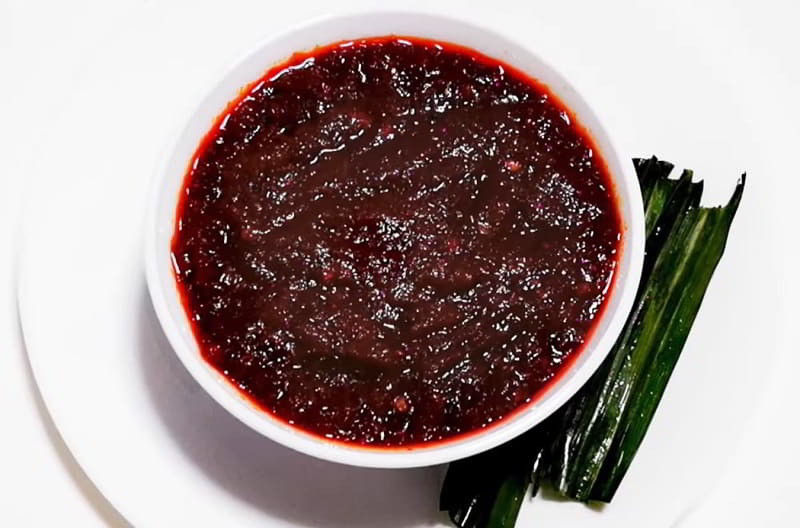
Sambal is a spicy condiment made from a variety of chili peppers, combined with other ingredients like garlic, shallots, shrimp paste, and lime juice. Sambal is usually prepared by grinding the ingredients together into a paste-like consistency. This versatile dish can be enjoyed with a wide range of Malay dishes, adding a burst of heat and tanginess to any meal. It is commonly used as a dipping sauce for grilled meats, seafood, and vegetables. Sambal is also often used as a base for cooking stir-fries and curries, where it infuses the dish with its rich and spicy flavors. The intensity of sambal can vary depending on the type and amount of chili peppers used. Some versions are milder and sweeter, while others are fiery hot. The shrimp paste adds a depth of umami flavor, while the lime juice provides a refreshing citrus note.
Satay
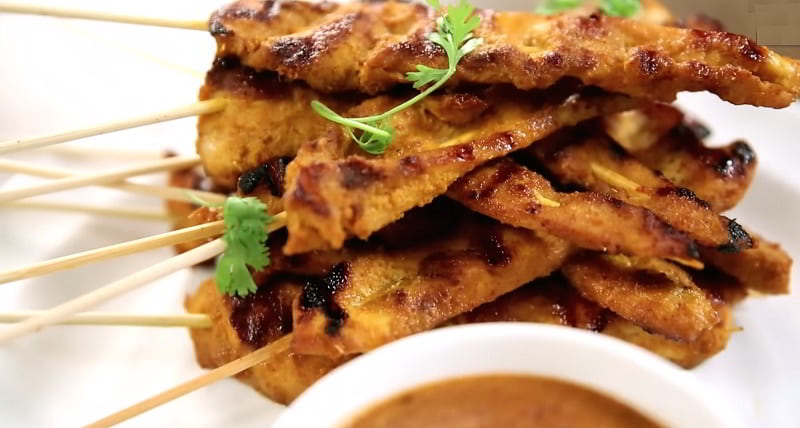
Satay is a skewered meat dish that is marinated and grilled to perfection. The meat used in satay can vary, but the most common choices are chicken, beef, and mutton. The meat is marinated in a flavorful mixture of spices such as turmeric, coriander, and cumin, which gives it a distinctive taste. The skewers are then grilled over an open flame, giving the satay a smoky and charred flavor. Satay is traditionally served with a peanut dipping sauce, which adds a creamy and nutty element to the dish. The sauce is made from ground peanuts, coconut milk, chili paste, and various spices, creating a perfect balance of flavors. Satay is often enjoyed as a street food or as an appetizer in Malay cuisine. It is commonly served with fragrant rice, cucumber slices, and onions. The combination of the tender and juicy meat, the aromatic spices, and the rich peanut sauce makes satay a truly satisfying and delicious dish.
Nasi Goreng
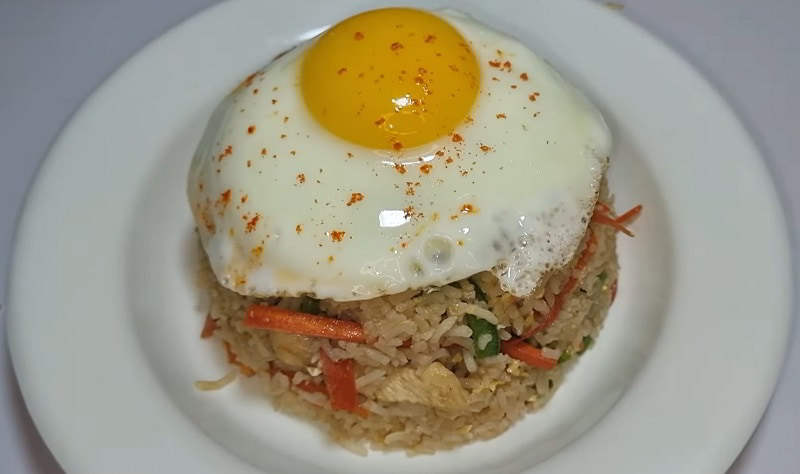
Nasi goreng is a popular fried rice dish that is bursting with aromatic spices and ingredients. The name "nasi goreng" translates to "fried rice" in English, and it is a staple in Malaysian households and street food stalls. The dish begins with steamed rice that is left to cool overnight, giving it a slightly dry texture that is perfect for frying. The rice is then stir-fried with a combination of ingredients such as shrimp, chicken, vegetables, and eggs. The key to a delicious nasi goreng lies in the seasoning. It is typically seasoned with soy sauce, fish sauce, and a blend of spices like garlic, ginger, and chili. Nasi goreng is known for its bold and complex flavors. The combination of savory, sweet, and spicy creates a symphony of tastes that is truly irresistible. It is often garnished with fresh herbs like cilantro or spring onions and served with a side of pickles or a fried egg on top. Whether enjoyed on its own or as a side dish, nasi goreng is a beloved Malaysian dish that is packed with flavor and a must-try for all food enthusiasts.
Roti Canai
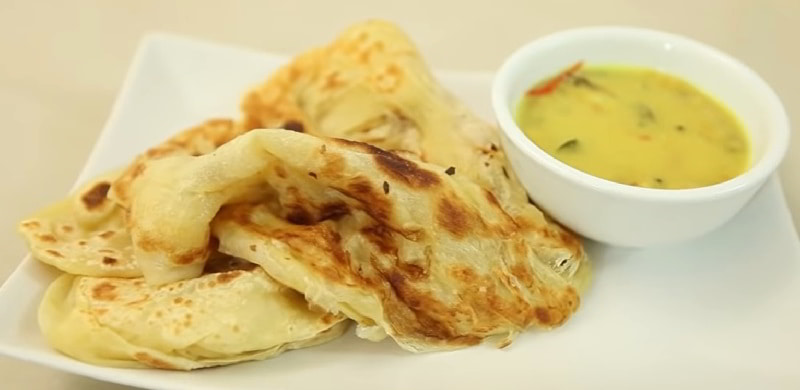
Roti canai is a type of Indian flatbread that is popular in several cuisines across Southeast Asia. The name "roti canai" is derived from the words "roti," which means bread, and "canai," which refers to the action of rolling and flipping the dough. The dough for roti canai is made from flour, water, and a small amount of oil. It is then kneaded and stretched until it becomes thin and elastic. The dough is then cooked on a hot griddle, resulting in a flaky and crispy bread. Roti canai is often served with various types of curry, such as chicken curry, lentil curry, or fish curry. It can also be enjoyed with condiments like dhal, a lentil-based stew, or sambal, a spicy chili paste. Some people also like to eat roti canai with sugar or condensed milk. The dish is not only delicious but also visually appealing, as the roti canai is often served folded or layered, creating a beautiful and intricate pattern. It is commonly eaten for breakfast or as a snack, but it can be enjoyed at any time of the day.
Murtabak
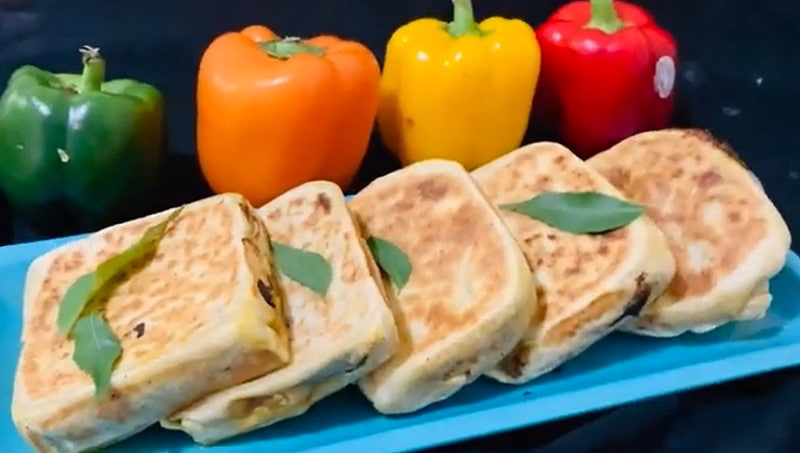
Murtabak is a delicious and popular dish in Malay cuisine. Originating from the Arab world, this dish has been adapted and incorporated into Malay cuisine, becoming a beloved street food and comfort food. Murtabak is a stuffed pancake that is typically filled with a combination of minced meat, onions, garlic, and spices. The meat filling can vary, with options like chicken, beef, or mutton being commonly used. The mixture is seasoned with a blend of aromatic spices such as cumin, coriander, turmeric, and chili powder, giving it a rich and flavorful taste. The pancake dough is made from flour, water, and sometimes eggs, resulting in a soft and slightly chewy texture. The dough is stretched and filled with the meat mixture before being folded and cooked on a hot griddle or pan until golden brown and crispy. Murtabak is often served with a side of tangy and spicy dipping sauce, usually made from a combination of soy sauce, lime juice, and chili. It is commonly enjoyed as a hearty meal or snack and can be found at hawker centers, food stalls, and even some restaurants throughout Malaysia and Singapore.



-1709813013.jpg)


